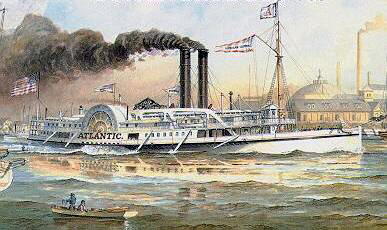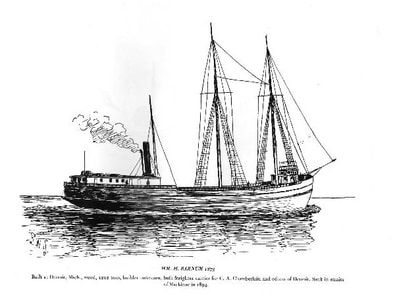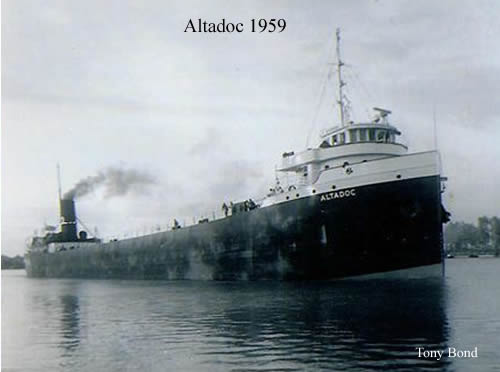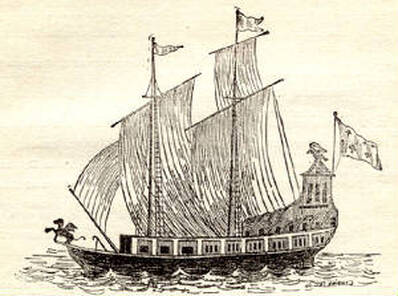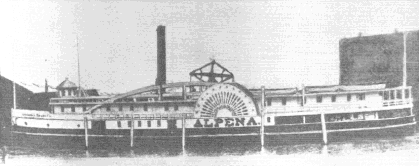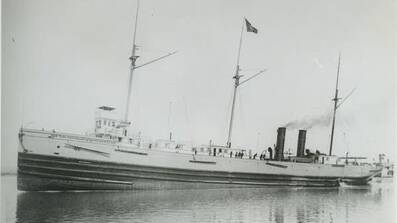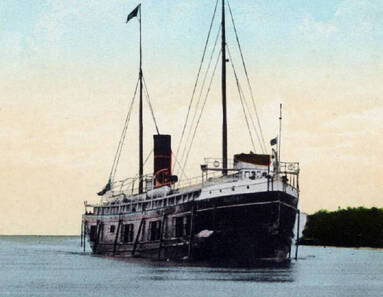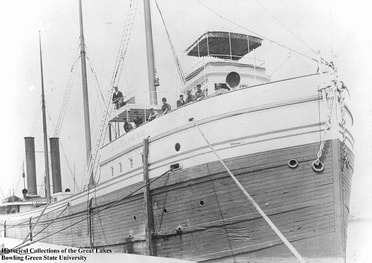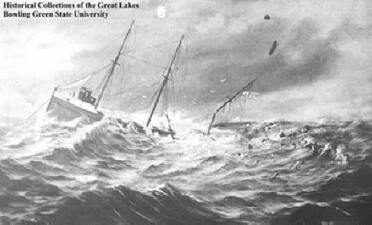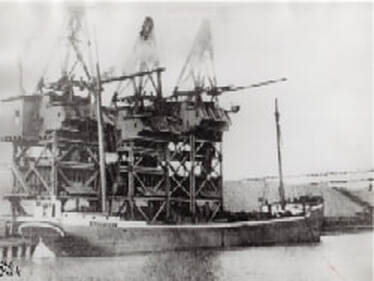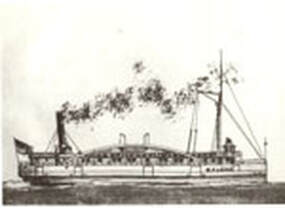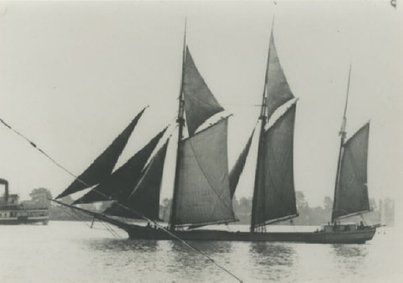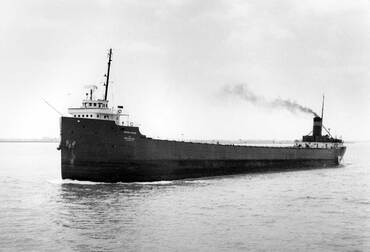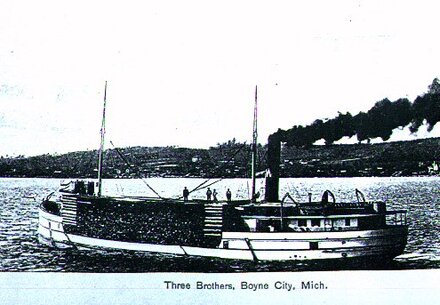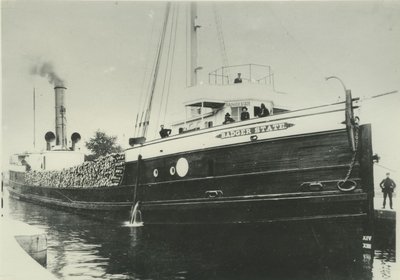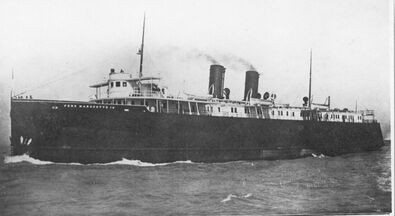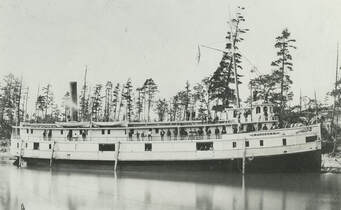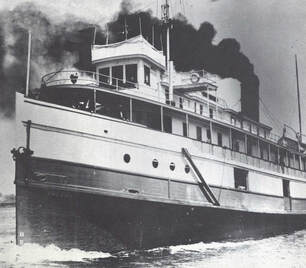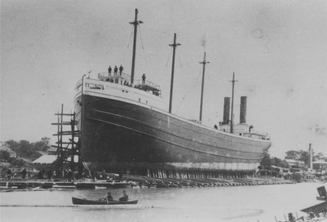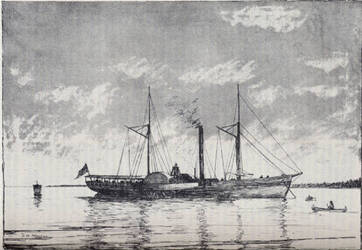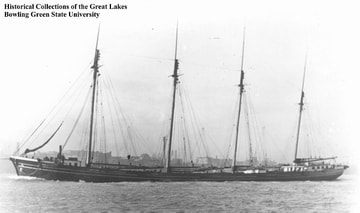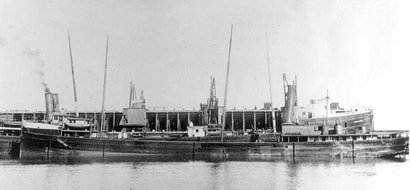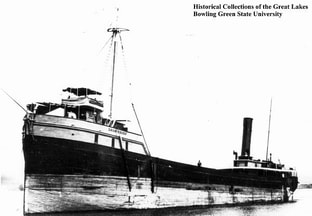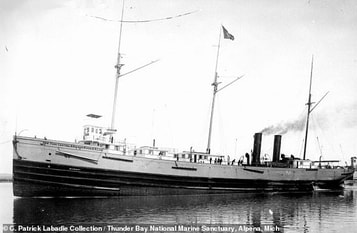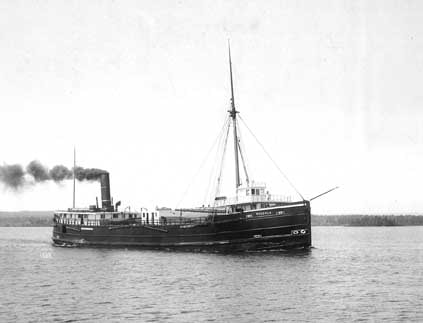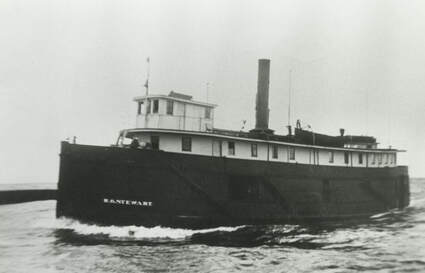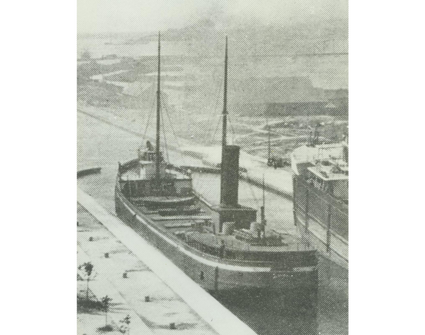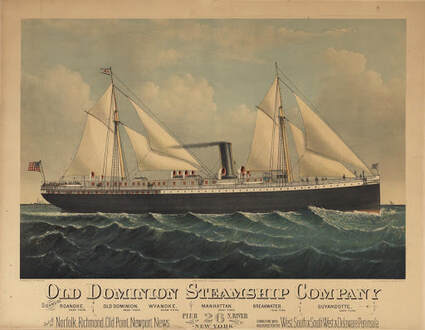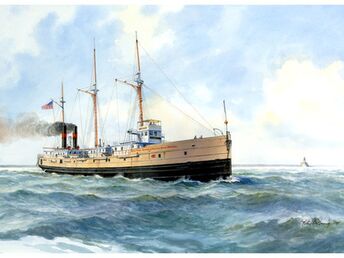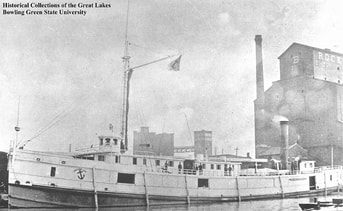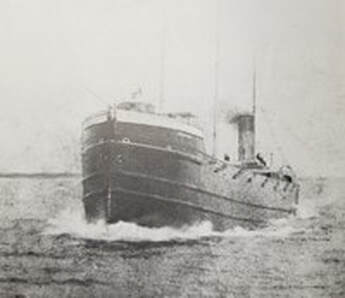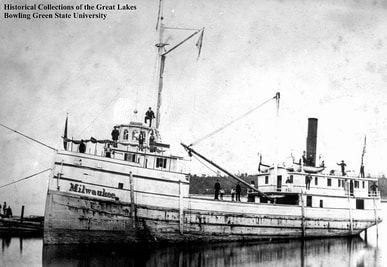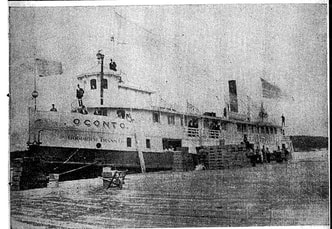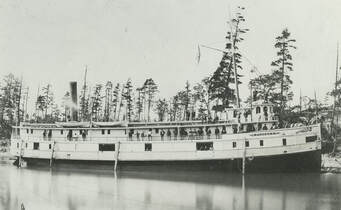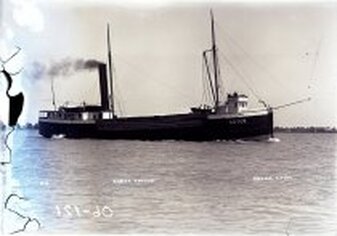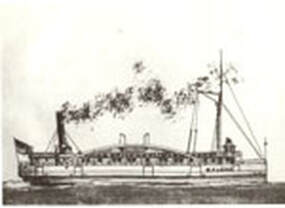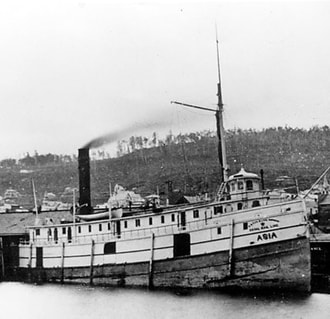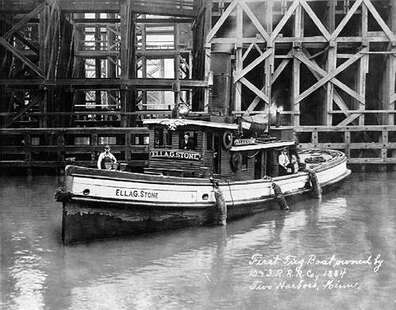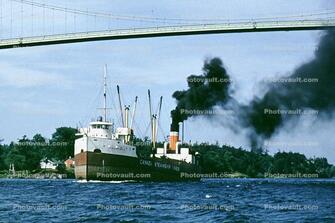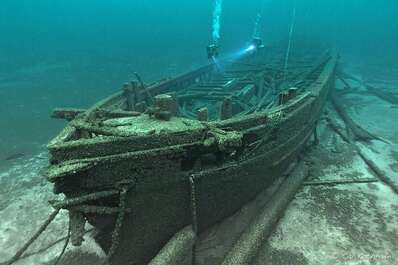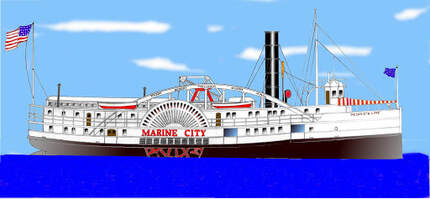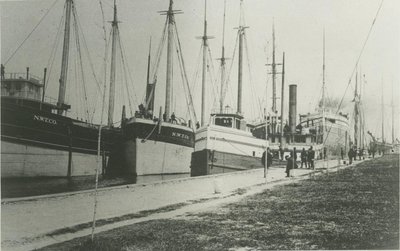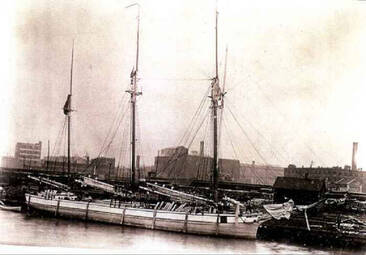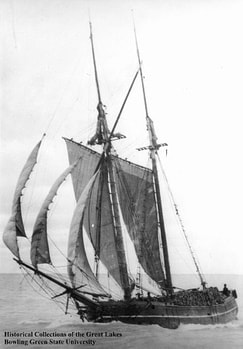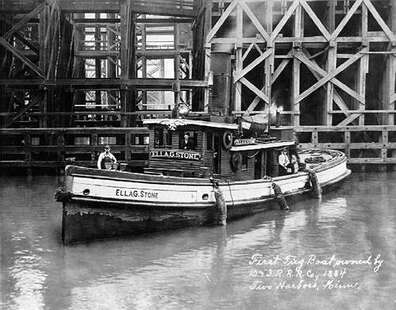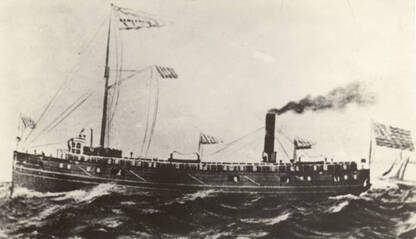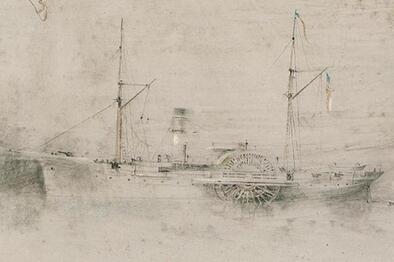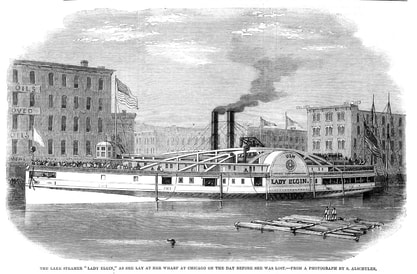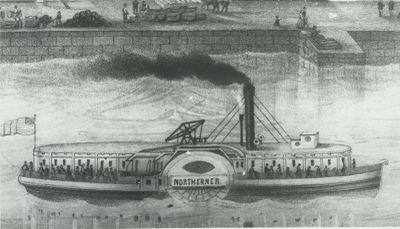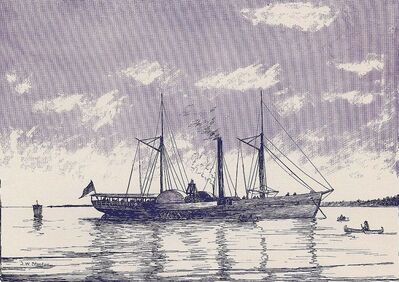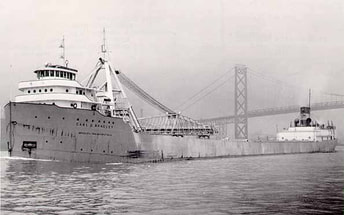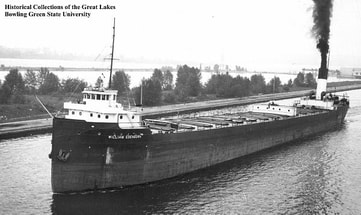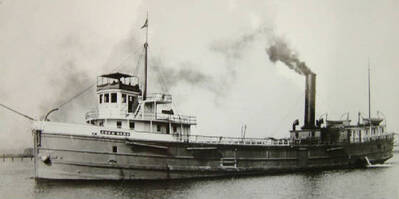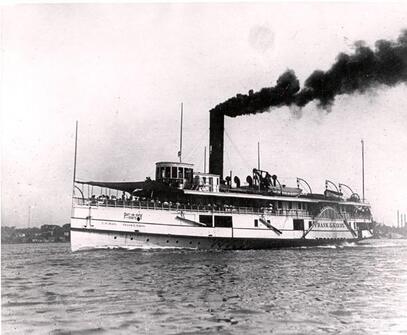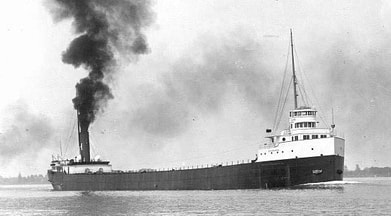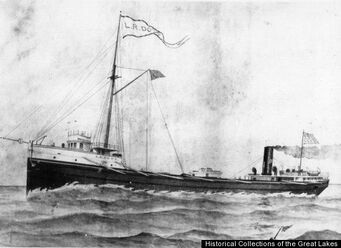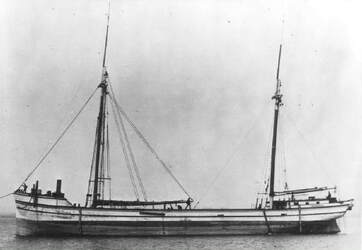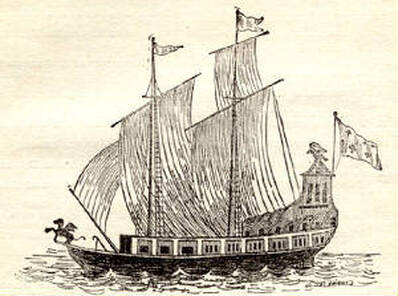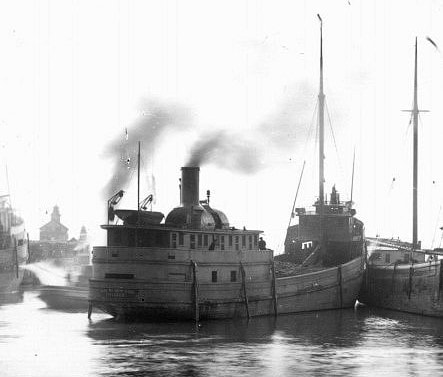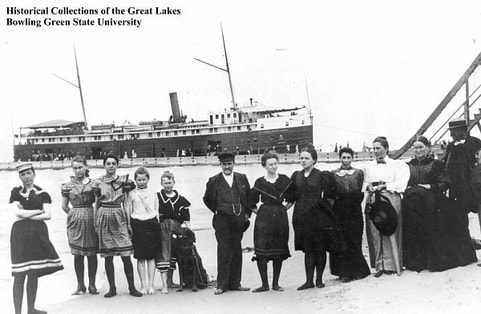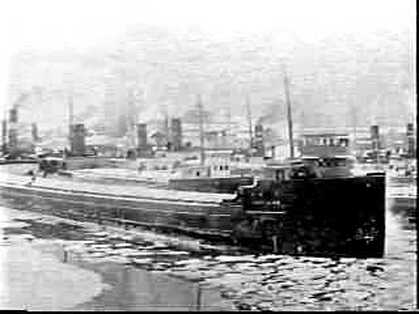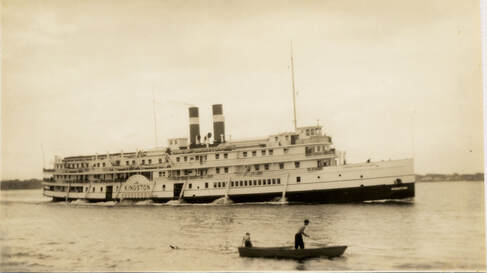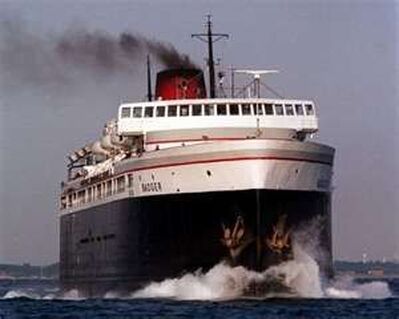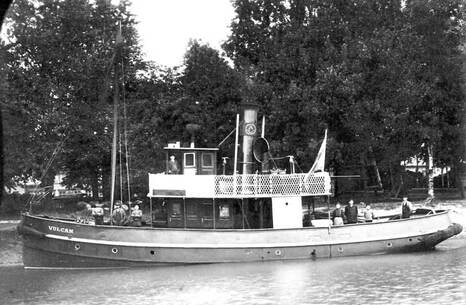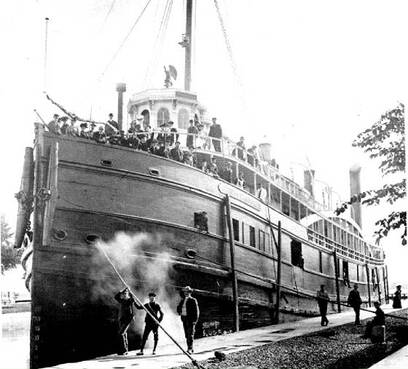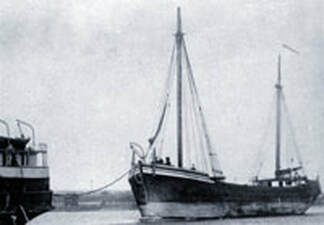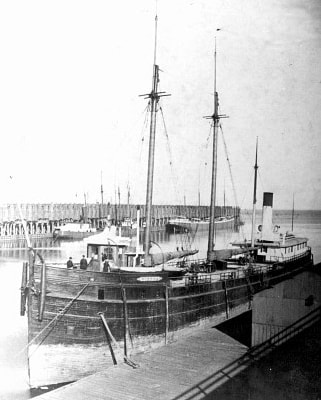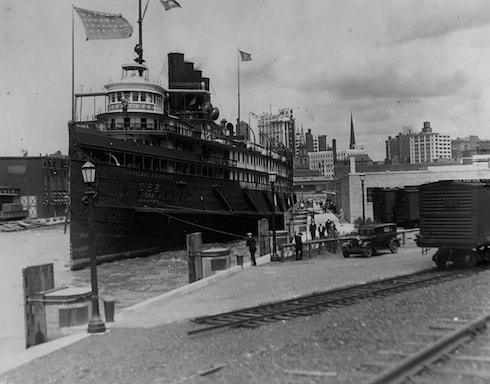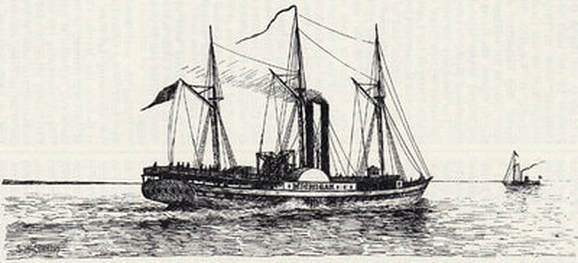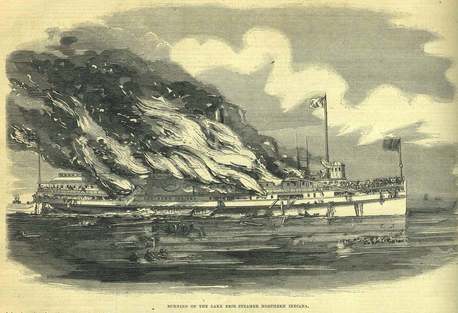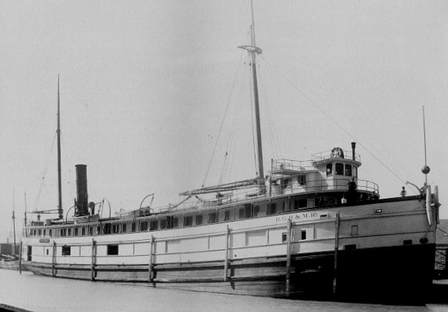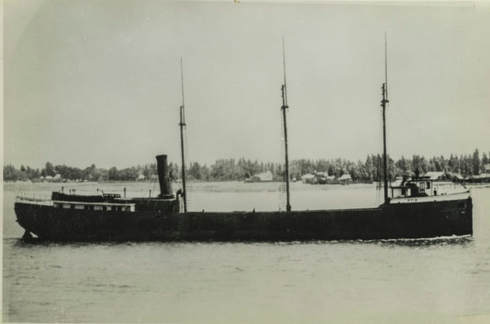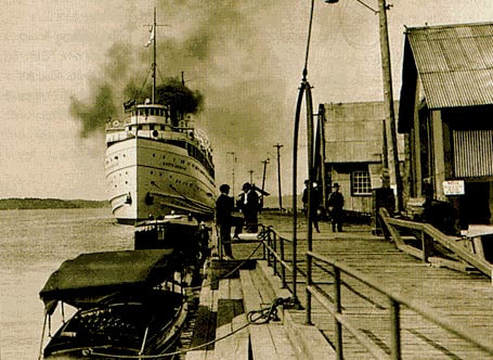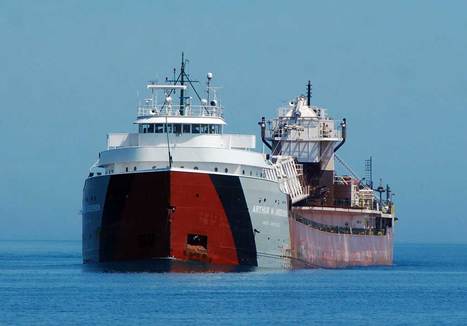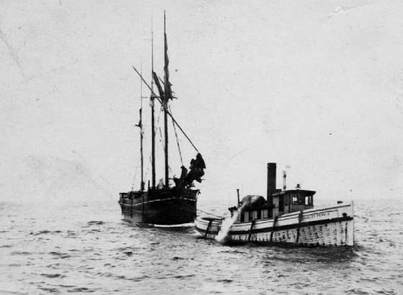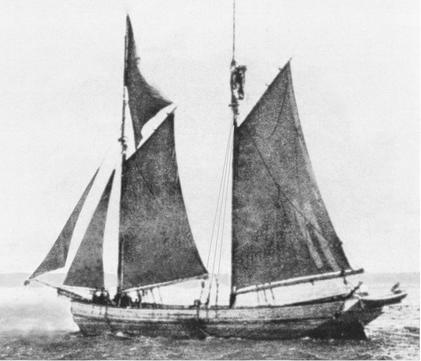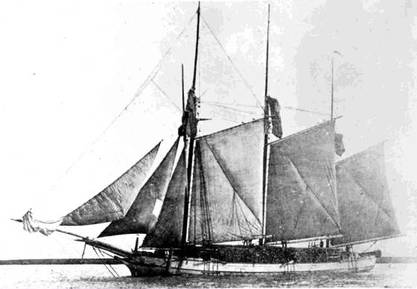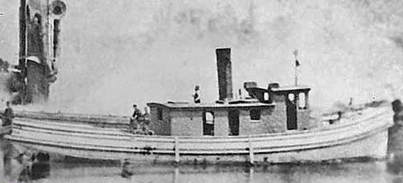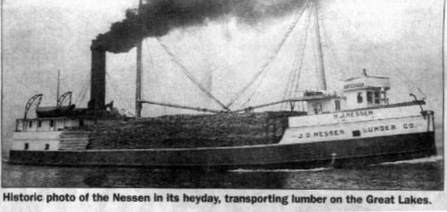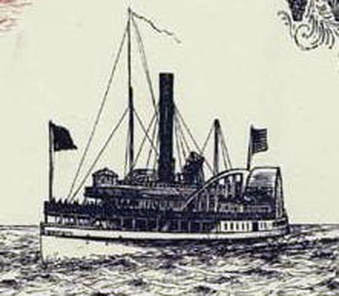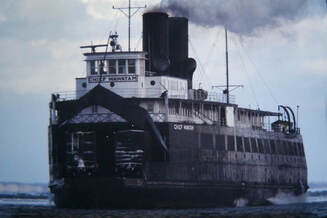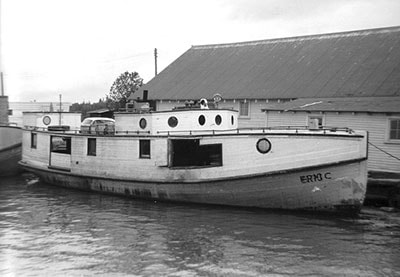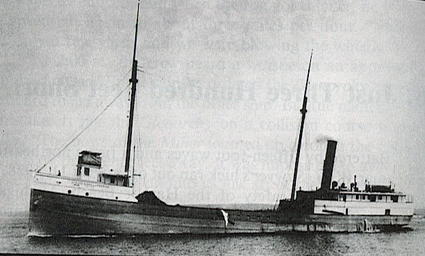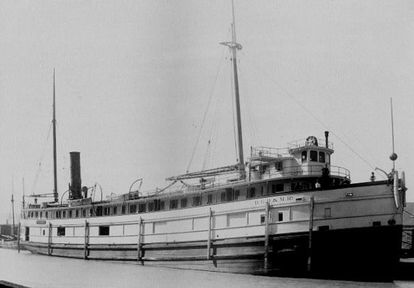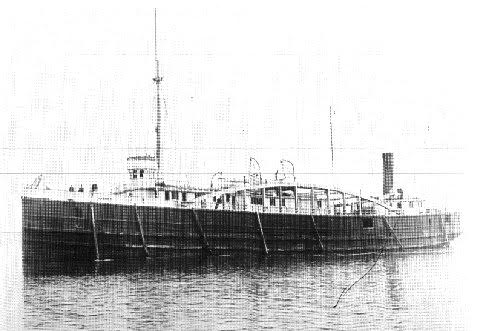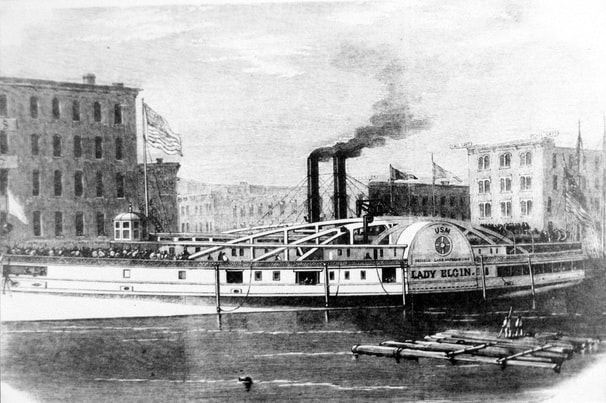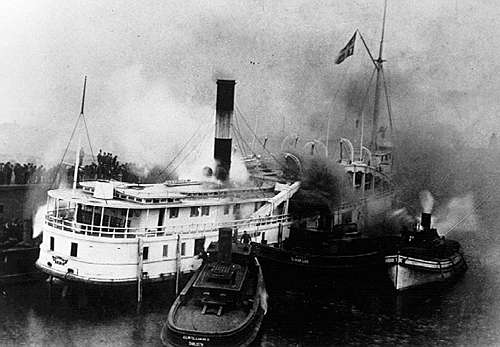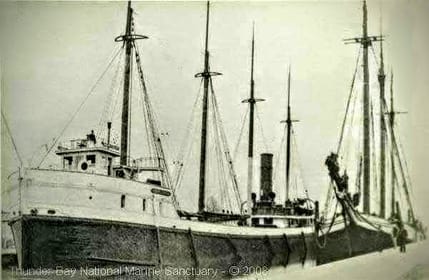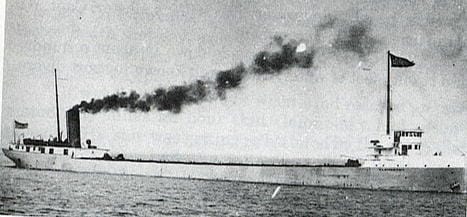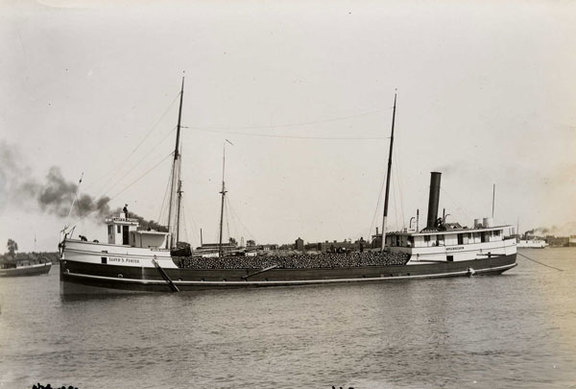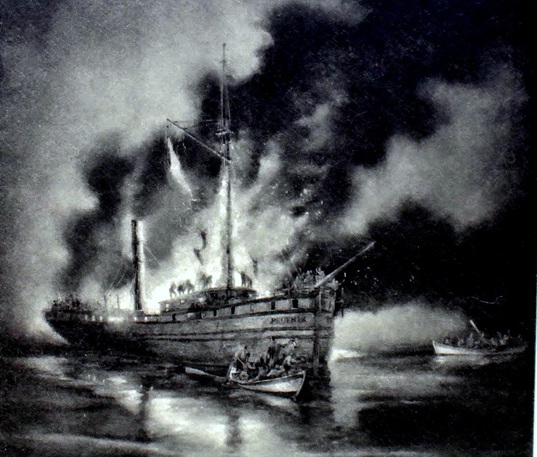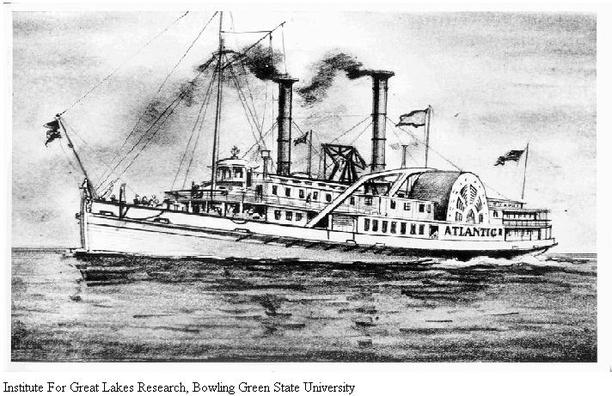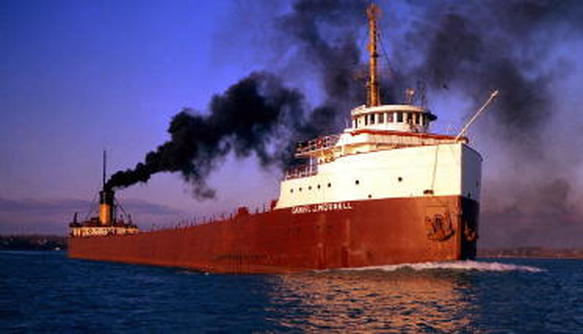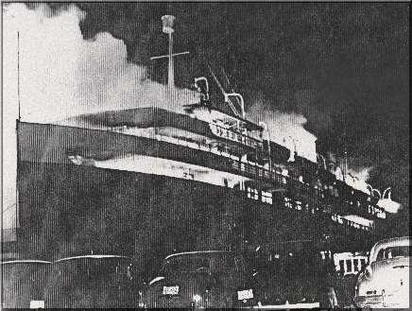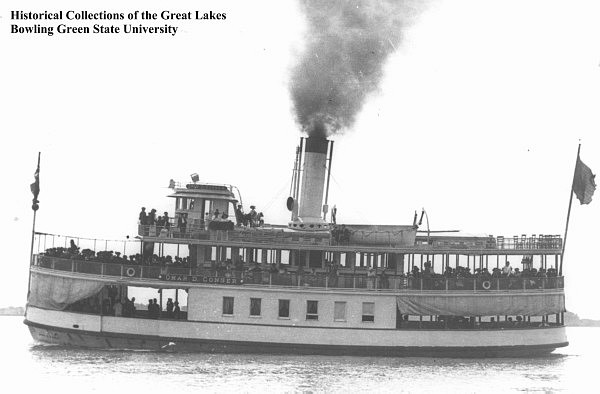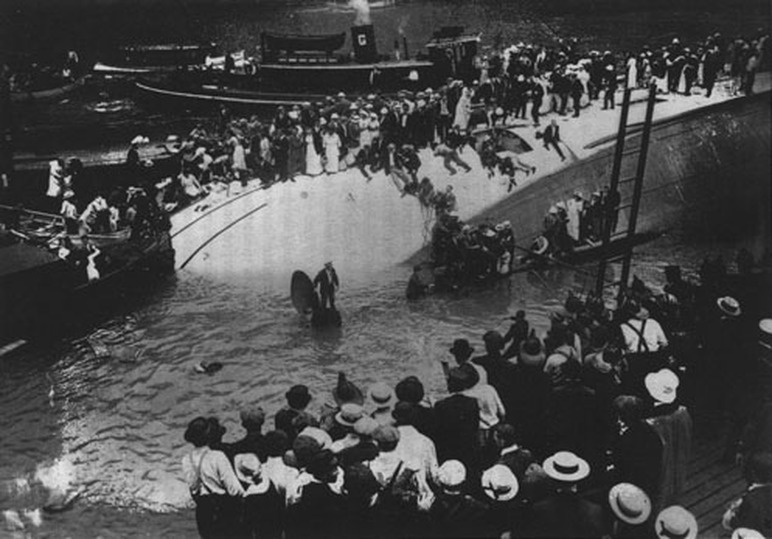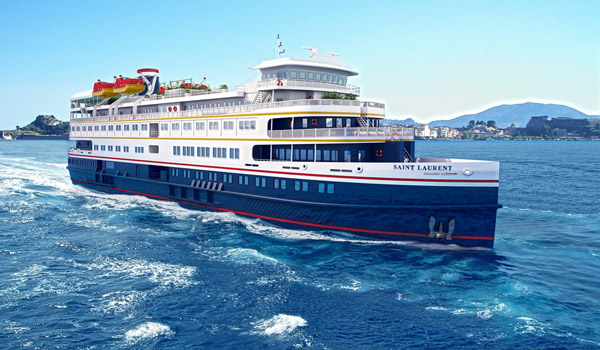Vessels of the Great Lakes:
The Great Atlantic Disaster
For years there was an old joke about how Lake Erie swallowed The Atlantic. It was a sick joke at best since it referred to one of the worst disasters on the Great Lakes. That wreck was the sinking of the steamer Atlantic and loss of between 130 and 250 lives following a collision with the steamer Ogdensburg. It happened in 1852, back in the days when steamboats were distinguished from propellers because they were driven by large wheels mounted on their sides. The Atlantic was such a boat.
For years there was an old joke about how Lake Erie swallowed The Atlantic. It was a sick joke at best since it referred to one of the worst disasters on the Great Lakes. That wreck was the sinking of the steamer Atlantic and loss of between 130 and 250 lives following a collision with the steamer Ogdensburg. It happened in 1852, back in the days when steamboats were distinguished from propellers because they were driven by large wheels mounted on their sides. The Atlantic was such a boat.
Sinking of the William H. Barnum
The wooden hulled steamer William H. Barnum had been on the lakes for 21 years at the time of its demise. Other vessels of its kind lasted a lot longer, but the Barnum was the victim of neglect. Thus in the spring of 1894, when the owners wanted the ship to carry a cargo of corn from Chicago to an unknown eastern port, and then proceed to dry dock for a rebuilding, insurance for the trip was not easy to obtain.
The wooden hulled steamer William H. Barnum had been on the lakes for 21 years at the time of its demise. Other vessels of its kind lasted a lot longer, but the Barnum was the victim of neglect. Thus in the spring of 1894, when the owners wanted the ship to carry a cargo of corn from Chicago to an unknown eastern port, and then proceed to dry dock for a rebuilding, insurance for the trip was not easy to obtain.
Wrecked Freighter Altadoc Sparked Tiny Tourist Attraction
It was an early winter gale on the Great Lakes that led to the destruction of the bulk carriers Altadoc, Agawa, Lambton and Martin. The date was Dec. 8, 1927. All four ships were driven aground and destroyed by the storm which packed near hurricane force winds of up to 70 miles an hour. The Altadoc, a Canadian-owned vessel, was steaming empty on Lake Superior, bound for Fort William, Ontario, when the storm drove it aground at Copper Harbor on Keweenaw Point, at the northern tip of Michigan.
It was an early winter gale on the Great Lakes that led to the destruction of the bulk carriers Altadoc, Agawa, Lambton and Martin. The date was Dec. 8, 1927. All four ships were driven aground and destroyed by the storm which packed near hurricane force winds of up to 70 miles an hour. The Altadoc, a Canadian-owned vessel, was steaming empty on Lake Superior, bound for Fort William, Ontario, when the storm drove it aground at Copper Harbor on Keweenaw Point, at the northern tip of Michigan.
.LaSalle’s Griffin, First Great Lakes Ship
French explorer and fur trader Rene Robert Cavelier de la Salle built the Griffin, the first ship to ever navigate the Great Lakes, in 1670. It was a sailing ship hewn from fresh-cut trees along the Niagara River, at the mouth of Cayuga Creek near the place where the town of La Salle, New York, stands today. Old drawings are but guesses of what the Griffin looked like, based upon ship design of that period. It is said the vessel was small, ranging from 45 to 60 tons burden. It carried seven brass cannons so technically was a ship of war even though its purpose was for the transport of furs from the lakes to New York for shipment to Europe. It took those early carpenters all the winter of 1678-79 to complete the vessel. It was launched that May.
French explorer and fur trader Rene Robert Cavelier de la Salle built the Griffin, the first ship to ever navigate the Great Lakes, in 1670. It was a sailing ship hewn from fresh-cut trees along the Niagara River, at the mouth of Cayuga Creek near the place where the town of La Salle, New York, stands today. Old drawings are but guesses of what the Griffin looked like, based upon ship design of that period. It is said the vessel was small, ranging from 45 to 60 tons burden. It carried seven brass cannons so technically was a ship of war even though its purpose was for the transport of furs from the lakes to New York for shipment to Europe. It took those early carpenters all the winter of 1678-79 to complete the vessel. It was launched that May.
Big Blow Of 1880 Claimed The Alpena
Some people said Captain Nelson W. Napier should have known better than take the Goodrich Line steamer Alpena out of Grand Haven, Michigan, on that fateful trip to Chicago on the night of Oct. 15, 1880. It was a beautiful Indian Summer evening, but the barometer was falling fast, and there were forecasts of a major gale brewing even before Napier’s ship weighed anchor that evening. All along the coast that evening the storm signals were out. As an experienced Great Lakes navigator, Napier should have known the dangers. He probably thought he had enough time to get across Lake Michigan and under the lee of the Illinois coast before the storm hit.
Some people said Captain Nelson W. Napier should have known better than take the Goodrich Line steamer Alpena out of Grand Haven, Michigan, on that fateful trip to Chicago on the night of Oct. 15, 1880. It was a beautiful Indian Summer evening, but the barometer was falling fast, and there were forecasts of a major gale brewing even before Napier’s ship weighed anchor that evening. All along the coast that evening the storm signals were out. As an experienced Great Lakes navigator, Napier should have known the dangers. He probably thought he had enough time to get across Lake Michigan and under the lee of the Illinois coast before the storm hit.
The Haunting of Captain McLean
The freighter John M. Nicol was in trouble. The boat had been fighting a fierce northeaster on Lake Superior for several hours on the morning of September 16, 1901, and her seams were starting to open. Capt. William “Bill” McLean had the Nicol steaming hard for the shelter of Michigan’s Keweenaw Peninsula, racing against time to save his command. He reasoned that once he got the Nicol close enough to land, if things got too bad he would drive the boat aground to save the twenty-one members of his crew. This was his state of mind at about 10:00 AM when the Nichol came upon the steamer Hudson in a sinking condition, about eight miles off Eagle River.
The freighter John M. Nicol was in trouble. The boat had been fighting a fierce northeaster on Lake Superior for several hours on the morning of September 16, 1901, and her seams were starting to open. Capt. William “Bill” McLean had the Nicol steaming hard for the shelter of Michigan’s Keweenaw Peninsula, racing against time to save his command. He reasoned that once he got the Nicol close enough to land, if things got too bad he would drive the boat aground to save the twenty-one members of his crew. This was his state of mind at about 10:00 AM when the Nichol came upon the steamer Hudson in a sinking condition, about eight miles off Eagle River.
Steamship Alberta – "The Terror of the Lakes"
The steel steamship Alberta gained a nickname, "The Terror of the Lakes," for good reason. It kept colliding with other vessels and was involved in the crash that sent the steamer John Osborne to the bottom on Lake Superior in 1884. The Alberta and its sister ship, the Algoma, were both steel-hulled ships built in Scotland and brought across the Atlantic Ocean and up the St. Lawrence River in 1883 for service on the Great Lakes. The Alberta, a monster for its day at 264-feet, had to be cut into two parts at Montreal so it could be towed through the Weland Canal. Then it was reassembled at Buffalo. The Alberta and Algoma were the first steel ships ever to ply the Great Lakes. The Algoma only lasted two years. She went on the rocks, broke apart and sank at Isle Royal in 1885. Click for Details
The steel steamship Alberta gained a nickname, "The Terror of the Lakes," for good reason. It kept colliding with other vessels and was involved in the crash that sent the steamer John Osborne to the bottom on Lake Superior in 1884. The Alberta and its sister ship, the Algoma, were both steel-hulled ships built in Scotland and brought across the Atlantic Ocean and up the St. Lawrence River in 1883 for service on the Great Lakes. The Alberta, a monster for its day at 264-feet, had to be cut into two parts at Montreal so it could be towed through the Weland Canal. Then it was reassembled at Buffalo. The Alberta and Algoma were the first steel ships ever to ply the Great Lakes. The Algoma only lasted two years. She went on the rocks, broke apart and sank at Isle Royal in 1885. Click for Details
Christmas Tree Ship La Rubida
The 30-year-old schooner La Rubida was laden with 10,000 Christmas trees, probably bound for her home port of South Haven, Michigan, when it was driven ashore and wrecked near Naubinway on Lake Michigan, on November 25, 1906. Naubinway is a small community located on Michigan’s Upper Peninsula near the Wisconsin border. Captain A. E. Dow and his crew of the 75-foot-long wooden schooner managed to escape to shore in spite of the bitter cold, and found shelter after spending a terrible night on the beach.
The 30-year-old schooner La Rubida was laden with 10,000 Christmas trees, probably bound for her home port of South Haven, Michigan, when it was driven ashore and wrecked near Naubinway on Lake Michigan, on November 25, 1906. Naubinway is a small community located on Michigan’s Upper Peninsula near the Wisconsin border. Captain A. E. Dow and his crew of the 75-foot-long wooden schooner managed to escape to shore in spite of the bitter cold, and found shelter after spending a terrible night on the beach.
Dramatic Rescue On The A. A. Parker
The rescue of the 18 crew members and two dogs from the deck of the sinking steamer A. A. Parker remains among the annuals of the dramatic stories in the history of the U.S. Live Saving Service.
The Parker sank on Lake Superior, just off Grand Maras, on Sept. 19, 1903. The story of what happened, and just how close those sailors came to losing their lives, reads like the plot of a contemporary adventure film produced on a Hollywood set. You almost feel the danger just reading the dull pages of government records.
The rescue of the 18 crew members and two dogs from the deck of the sinking steamer A. A. Parker remains among the annuals of the dramatic stories in the history of the U.S. Live Saving Service.
The Parker sank on Lake Superior, just off Grand Maras, on Sept. 19, 1903. The story of what happened, and just how close those sailors came to losing their lives, reads like the plot of a contemporary adventure film produced on a Hollywood set. You almost feel the danger just reading the dull pages of government records.
Storm Destroys The Akeley
The steamship H. C. Akeley was only three years old when a furious November gale literally tore it into pieces, killing the captain and five other crew members on Lake Michigan in 1883. Had it not been for the courage of the crew of the schooner Driver, that stood by the stricken steamer to take aboard 12 other crew members who escaped on the ship’s only surviving lifeboat, the casualty count would have been much worse.
The steamship H. C. Akeley was only three years old when a furious November gale literally tore it into pieces, killing the captain and five other crew members on Lake Michigan in 1883. Had it not been for the courage of the crew of the schooner Driver, that stood by the stricken steamer to take aboard 12 other crew members who escaped on the ship’s only surviving lifeboat, the casualty count would have been much worse.
Adriatic And Baltic Lost In Same Lake Erie Gale
Fourteen sailors perished when the schooner barges Adriatic and Baltic broke loose from the tug that had them in tow and wrecked during a severe Lake Erie Gale in 1872. The barges were in a line of vessels in tow behind the tug Moore, believed to have been the William A. Moore that was on the Great Lakes that year. The vessels were all bound for Saginaw, Michigan, which means they were probably involved in carrying lumber to the mills at Tonawanda, New York. They were either returning without cargo or were laden with coal. That was standard cargo for lumber carriers on return trips from Lake Erie ports.
Fourteen sailors perished when the schooner barges Adriatic and Baltic broke loose from the tug that had them in tow and wrecked during a severe Lake Erie Gale in 1872. The barges were in a line of vessels in tow behind the tug Moore, believed to have been the William A. Moore that was on the Great Lakes that year. The vessels were all bound for Saginaw, Michigan, which means they were probably involved in carrying lumber to the mills at Tonawanda, New York. They were either returning without cargo or were laden with coal. That was standard cargo for lumber carriers on return trips from Lake Erie ports.
Wreck Of The Galena
The 193-foot-long wooden propeller slammed into the rocks with a sudden jolt that threw passengers from their bunks and rattled pans in the galley. Broadbridge grabbed the chadburn and sent the order to the engine room to reverse the engines. His first hope was that the ship could break free and that the hull was not severely damaged. But the steamer didn’t budge.
The 193-foot-long wooden propeller slammed into the rocks with a sudden jolt that threw passengers from their bunks and rattled pans in the galley. Broadbridge grabbed the chadburn and sent the order to the engine room to reverse the engines. His first hope was that the ship could break free and that the hull was not severely damaged. But the steamer didn’t budge.
Strange Disappearance of the Thomas Hume
When the schooner Thomas Hume went missing in a Lake Michigan gale on May 21, 1891, everybody assumed that the ship sank. After a week passed and the usual trappings from such a disaster; floating timbers, life jackets, lifeboats and bodies, failed to turn up, people realized they had a mystery on their hands. The Hume had disappeared without a trace. The loss of the vessel remained a mystery until 2016 when a wreck, believed to be the Hume, was discovered in 200 feet on the bottom of Lake Michigan.
When the schooner Thomas Hume went missing in a Lake Michigan gale on May 21, 1891, everybody assumed that the ship sank. After a week passed and the usual trappings from such a disaster; floating timbers, life jackets, lifeboats and bodies, failed to turn up, people realized they had a mystery on their hands. The Hume had disappeared without a trace. The loss of the vessel remained a mystery until 2016 when a wreck, believed to be the Hume, was discovered in 200 feet on the bottom of Lake Michigan.
Remembering Historic Carrier Amasa Stone
Named for an American industrialist linked to tragedy, the Great Lakes steamship Amasa Stone served 55 successful years hauling grain, ore, coal and other goods between Duluth, Chicago and Buffalo. Her stripped-down hull continues to serve as a breakwater at the entrance to Charlevoix, Michigan, on the Lake Michigan coast. The Stone was built by Detroit Ship Building Co. at Wyandotte and launched for the Mesaba Steamship Co. in 1905. It was named for Amasha Stone, 1818-1883, who built railroads and invested in mills and education. Stone committed suicide after a railroad bridge he helped design collapsed over the Ashtabula River, carrying 159 passengers and railroad workers to their deaths in 1876.
Named for an American industrialist linked to tragedy, the Great Lakes steamship Amasa Stone served 55 successful years hauling grain, ore, coal and other goods between Duluth, Chicago and Buffalo. Her stripped-down hull continues to serve as a breakwater at the entrance to Charlevoix, Michigan, on the Lake Michigan coast. The Stone was built by Detroit Ship Building Co. at Wyandotte and launched for the Mesaba Steamship Co. in 1905. It was named for Amasha Stone, 1818-1883, who built railroads and invested in mills and education. Stone committed suicide after a railroad bridge he helped design collapsed over the Ashtabula River, carrying 159 passengers and railroad workers to their deaths in 1876.
Erie Horror Story
Chief engineer A. Welch’s story of survival aboard the burning freighter Clarion was enough to send a cold chill down the spine of the most hardened Great Lakes sailor. Welch and five other men found themselves trapped aboard the burning boat, in the night, with a serious winter gale blowing, in the middle of Lake Erie, and without a lifeboat. It happened the night of December 8, 1909. Welch told of leading his small band of men in a four-hour fight for their lives, and successfully holding back the flames until the steamer L. C Hanna came alongside. “The intense heat had driven us to about the limit of endurance when we were rescued,” he said. The other men, identified as second engineer John Graham, firemen Harry Murray, Theodore Larson and Joseph Baker, and cook Michael Toomey, praised Welch for his leadership during the crisis.
Chief engineer A. Welch’s story of survival aboard the burning freighter Clarion was enough to send a cold chill down the spine of the most hardened Great Lakes sailor. Welch and five other men found themselves trapped aboard the burning boat, in the night, with a serious winter gale blowing, in the middle of Lake Erie, and without a lifeboat. It happened the night of December 8, 1909. Welch told of leading his small band of men in a four-hour fight for their lives, and successfully holding back the flames until the steamer L. C Hanna came alongside. “The intense heat had driven us to about the limit of endurance when we were rescued,” he said. The other men, identified as second engineer John Graham, firemen Harry Murray, Theodore Larson and Joseph Baker, and cook Michael Toomey, praised Welch for his leadership during the crisis.
Three Brothers Slammed Into An Island
The aging lumber hooker Three Brothers wrecked during a Lake Michigan storm on Sept. 27, 1911, while steaming from Boyne City to Chicago with a cargo of hardwood. The 162-foot-long wooden vessel, under the command of Capt. Sam Christopher, began to leak shortly after leaving Boyne City. The leak worsened as the day progressed until the water overwhelmed the ship’s bilge pumps. Captain Christopher turned the vessel toward the nearest shore. He had full steam up when he ran the Three Brothers hard aground on South Manitou Island. The old boat literally plowed into the shoreline about 200 yards east of the lifesaving station. The crash split the ship’s bow open and dislodged the pilot house from the superstructure.
The aging lumber hooker Three Brothers wrecked during a Lake Michigan storm on Sept. 27, 1911, while steaming from Boyne City to Chicago with a cargo of hardwood. The 162-foot-long wooden vessel, under the command of Capt. Sam Christopher, began to leak shortly after leaving Boyne City. The leak worsened as the day progressed until the water overwhelmed the ship’s bilge pumps. Captain Christopher turned the vessel toward the nearest shore. He had full steam up when he ran the Three Brothers hard aground on South Manitou Island. The old boat literally plowed into the shoreline about 200 yards east of the lifesaving station. The crash split the ship’s bow open and dislodged the pilot house from the superstructure.
Bad Years for the Badger State
If records were kept for the volume of freight and passengers hauled on the Great Lakes, the propeller Badger State might have held one. The two hundred ten-foot long steamer competed on the route between Buffalo and Chicago in 1862. The boat was still going strong forty-seven years later, although by then it was reduced to the role of a tired lumber hooker when destroyed by a fire at Marine City, Michigan, on December 6, 1909. Four years before it burned, the Badger State fell into a period of disrepute. Still rigged as a passenger and freight hauler, the vessel was chartered by a Detroit gambling syndicate and was refurbished as a floating pleasure palace.
If records were kept for the volume of freight and passengers hauled on the Great Lakes, the propeller Badger State might have held one. The two hundred ten-foot long steamer competed on the route between Buffalo and Chicago in 1862. The boat was still going strong forty-seven years later, although by then it was reduced to the role of a tired lumber hooker when destroyed by a fire at Marine City, Michigan, on December 6, 1909. Four years before it burned, the Badger State fell into a period of disrepute. Still rigged as a passenger and freight hauler, the vessel was chartered by a Detroit gambling syndicate and was refurbished as a floating pleasure palace.
The Unexplained Loss of Pere Marquette No. 18
The sinking of the railroad car ferry Pere Marquette No. 18 on September 19, 1910 still remains one of Lake Michigan’s unsolved mysteries. The boat took twenty-nine passengers and crew members to the bottom with her and caused the deaths of two sailors from another vessel that fell from an overturned lifeboat to drown during rescue operations. Miraculously, another thirty-three of the sixty-two souls aboard the doomed ferry were pulled alive from the water. The cause of the sinking has remained a mystery. The seas were running high but the weather was fair. The vessel was not overloaded. Her engines and machinery were working. The vessel was making a first run for the ferry service after spending the summer operating as an excursion liner between Chicago and Waukegan. It passed a government inspection at Ludington the day before it sank. How, then, could it have happened?
The sinking of the railroad car ferry Pere Marquette No. 18 on September 19, 1910 still remains one of Lake Michigan’s unsolved mysteries. The boat took twenty-nine passengers and crew members to the bottom with her and caused the deaths of two sailors from another vessel that fell from an overturned lifeboat to drown during rescue operations. Miraculously, another thirty-three of the sixty-two souls aboard the doomed ferry were pulled alive from the water. The cause of the sinking has remained a mystery. The seas were running high but the weather was fair. The vessel was not overloaded. Her engines and machinery were working. The vessel was making a first run for the ferry service after spending the summer operating as an excursion liner between Chicago and Waukegan. It passed a government inspection at Ludington the day before it sank. How, then, could it have happened?
Wreck of the Goodyear
The ore carrier Frank H. Goodyear was the flagship of the Buffalo Steamship Company fleet. Named for the man who developed the famous Pullman railroad car, the Goodyear was distinguished by an ornate Pullman car attached to her deck. That railroad car, complete with a grand piano and fine furnishings, went to the bottom of Lake Huron with the Goodyear and seventeen terrified crew members after a collision with the freighter James B. Wood in thick fog off Point aux Barques. The date was May 23, 1910.
The ore carrier Frank H. Goodyear was the flagship of the Buffalo Steamship Company fleet. Named for the man who developed the famous Pullman railroad car, the Goodyear was distinguished by an ornate Pullman car attached to her deck. That railroad car, complete with a grand piano and fine furnishings, went to the bottom of Lake Huron with the Goodyear and seventeen terrified crew members after a collision with the freighter James B. Wood in thick fog off Point aux Barques. The date was May 23, 1910.
“She Will Be My Coffin”
Capt. John McKay had a love for the sea and an equal love for his fellow man. He had the best of both worlds. As an experienced master he commanded some well-known steamboats on the Great Lakes in the 1870s. Although his last command, the twelve-year-old steamer Manistee, was not so accommodating as some of the newer steamboats operating in 1883, people liked to book passage on it because they said the preferred traveling with “Johnny McKay.” They were drawn to the man because McKay loved people. He carried that devotion to his death when the Manistee foundered in a bad Lake Superior storm off Bayfield, Wisconsin, on November 16, 1883. One of the three survivors later said McKay refused to leave his sinking ship because nearly all the lifeboats were smashed or carried away by the storm and it was obvious that people were going to be left behind. “I am captain of this boat, and if she is a coffin for anybody, she will be my coffin,” he was quoted as saying.
Capt. John McKay had a love for the sea and an equal love for his fellow man. He had the best of both worlds. As an experienced master he commanded some well-known steamboats on the Great Lakes in the 1870s. Although his last command, the twelve-year-old steamer Manistee, was not so accommodating as some of the newer steamboats operating in 1883, people liked to book passage on it because they said the preferred traveling with “Johnny McKay.” They were drawn to the man because McKay loved people. He carried that devotion to his death when the Manistee foundered in a bad Lake Superior storm off Bayfield, Wisconsin, on November 16, 1883. One of the three survivors later said McKay refused to leave his sinking ship because nearly all the lifeboats were smashed or carried away by the storm and it was obvious that people were going to be left behind. “I am captain of this boat, and if she is a coffin for anybody, she will be my coffin,” he was quoted as saying.
Strange Disappearance of the Soo City
After a successful twenty-year career on the Great Lakes, the ornate passenger steamer Soo City met her end in a cloak of mystery on the North Atlantic. Nineteen sailors died when the ship disappeared sometimes between November 14 and December 4, 1908, while steaming from Quebec down the Atlantic coast. The first that anyone knew something happened was when wreckage began washing ashore December 4 near North Sidney, Nova Scotia.
After a successful twenty-year career on the Great Lakes, the ornate passenger steamer Soo City met her end in a cloak of mystery on the North Atlantic. Nineteen sailors died when the ship disappeared sometimes between November 14 and December 4, 1908, while steaming from Quebec down the Atlantic coast. The first that anyone knew something happened was when wreckage began washing ashore December 4 near North Sidney, Nova Scotia.
Lake Huron’s Ghost Ship Kaliyuga
When Simon Langell built his big new steamer at the St. Clair Michigan shipyards in 1887, he named it Kaliyuga, an ancient name that was supposed to mean “age of iron.” It was an inappropriate name for this steamer, because, though it was built early during the age of iron ships, the Kaliyuga was among the last of the wooden-hulled steamers. Had it been made of iron, perhaps it might have been strong enough to withstand the storm that claimed it. The steamer foundered with all hands somewhere in Lake Huron on October 19, 1905.
When Simon Langell built his big new steamer at the St. Clair Michigan shipyards in 1887, he named it Kaliyuga, an ancient name that was supposed to mean “age of iron.” It was an inappropriate name for this steamer, because, though it was built early during the age of iron ships, the Kaliyuga was among the last of the wooden-hulled steamers. Had it been made of iron, perhaps it might have been strong enough to withstand the storm that claimed it. The steamer foundered with all hands somewhere in Lake Huron on October 19, 1905.
Strange Steamboat Walk-in-the-Water
The first steamboat on the Great Lakes was the Walk-in-the-water, launched in 1818.There is a legend that the boat got its name from an Indian that watched Robert Fulton's steamboat Clermont as it huffed and puffed its way up the Hudson River just 11 years earlier. As the vessel moved upstream against the river current without the help of sails and wind, and he watched the turning paddle wheels, the native remarked that the vessel "walked in the water." While officially named the Walk-in-the-Water, the vessel was most commonly known to the people around the Great Lakes as "the steamboat." That was because it was the only operating steamboat during the three years of its existence.
The first steamboat on the Great Lakes was the Walk-in-the-water, launched in 1818.There is a legend that the boat got its name from an Indian that watched Robert Fulton's steamboat Clermont as it huffed and puffed its way up the Hudson River just 11 years earlier. As the vessel moved upstream against the river current without the help of sails and wind, and he watched the turning paddle wheels, the native remarked that the vessel "walked in the water." While officially named the Walk-in-the-Water, the vessel was most commonly known to the people around the Great Lakes as "the steamboat." That was because it was the only operating steamboat during the three years of its existence.
Saga of the Olive Jeannette
When the steamer Iosco and her tow, the schooner Olive Jeannette, foundered with all hands during a Lake Superior gale in 1905, lake men wondered if the schooner was cursed. The Jeannette was involved in an almost identical disaster, that time with the Iosco’s sister vessel, the L. R. Doty, during a storm on Lake Michigan in 1898. The Doty sank with all hands, but the Jeannette hoisted sail and survived to sail again. Seventeen sailors perished when the Doty, owned by the Cuyahoga Transit Company of Chicago, disappeared in the gale of October 25. Capt. David B. Cadotte, forty-eight-year-old master of the Jeannette, was credited with bringing his schooner through the storm against almost impossible odds. That story is among the best in the annals of lake lore. But it did not end here.
When the steamer Iosco and her tow, the schooner Olive Jeannette, foundered with all hands during a Lake Superior gale in 1905, lake men wondered if the schooner was cursed. The Jeannette was involved in an almost identical disaster, that time with the Iosco’s sister vessel, the L. R. Doty, during a storm on Lake Michigan in 1898. The Doty sank with all hands, but the Jeannette hoisted sail and survived to sail again. Seventeen sailors perished when the Doty, owned by the Cuyahoga Transit Company of Chicago, disappeared in the gale of October 25. Capt. David B. Cadotte, forty-eight-year-old master of the Jeannette, was credited with bringing his schooner through the storm against almost impossible odds. That story is among the best in the annals of lake lore. But it did not end here.
Chasing the Queen
Captain McKenzie was perplexed. Here he was, early in the day on August 20, 1903, piloting his boat through rough seas on Lake Erie, trying to rescue people from the sinking ore carrier Queen of the West, but the ill-fated boat was running away from him at full steam. McKenzie was probably thinking the Queen’s master, Capt. S. B. Massey of Ogdensburg, New York, had lost his senses. “She was running away from us with full steam,” he said. As the Cordorus gained and the two racing boats drew near each other, McKenzie said it was obvious that the people on the Queen of the West needed rescuing and very soon. He said the sea had washed away the lifeboats and several people were on deck, clinging to anything they could hang onto, as the moving boat settled lower and lower in the water.
Captain McKenzie was perplexed. Here he was, early in the day on August 20, 1903, piloting his boat through rough seas on Lake Erie, trying to rescue people from the sinking ore carrier Queen of the West, but the ill-fated boat was running away from him at full steam. McKenzie was probably thinking the Queen’s master, Capt. S. B. Massey of Ogdensburg, New York, had lost his senses. “She was running away from us with full steam,” he said. As the Cordorus gained and the two racing boats drew near each other, McKenzie said it was obvious that the people on the Queen of the West needed rescuing and very soon. He said the sea had washed away the lifeboats and several people were on deck, clinging to anything they could hang onto, as the moving boat settled lower and lower in the water.
Loss of the Iron Chief
A ship’s graveyard lies just off the northeast tip of Lower Michigan’s little peninsula, within sight of the old lighthouse at Lake Huron’s Pointe aux Barques. When the weather is good, sport divers like to visit some of the better-known wrecks, all bunched within a few miles of one another. But they are deep dives, many of them up to one hundred fifty feet down, and only the most experienced divers dare visit them. Among these wrecks is the Iron Chief, a two hundred twelve-foot wooden-hulled steamer that met its fate on October 3, 1904. Built as a schooner twenty-three years earlier in Detroit, the Iron Chief later was converted to be a steam barge. She never lost the grace she had as a sailing ship, and she carried her four masts until the day she sank.
A ship’s graveyard lies just off the northeast tip of Lower Michigan’s little peninsula, within sight of the old lighthouse at Lake Huron’s Pointe aux Barques. When the weather is good, sport divers like to visit some of the better-known wrecks, all bunched within a few miles of one another. But they are deep dives, many of them up to one hundred fifty feet down, and only the most experienced divers dare visit them. Among these wrecks is the Iron Chief, a two hundred twelve-foot wooden-hulled steamer that met its fate on October 3, 1904. Built as a schooner twenty-three years earlier in Detroit, the Iron Chief later was converted to be a steam barge. She never lost the grace she had as a sailing ship, and she carried her four masts until the day she sank.
The Haunting of Captain McLean
(Wreck of the Hudson)
The freighter John M. Nicol was in trouble. The boat had been fighting a fierce northeaster on Lake Superior for several hours on the morning of September 16, 1901, and her seams were starting to open. The pumps were not keeping up with the water surging into her vast hold. Then, just about dawn, chief engineer George E. Tretheway called Capt. William “Bill” McLean to the engine room to give him some more bad news. He showed McLean how the boat’s steam pipes were starting to work loose because of the wild wrenching and twisting the vessel’s hull was taking. “This boat can’t stand the strain much longer,” Tretheway warned. McLean had the Nicol steaming hard for the shelter of Michigan’s Keweenaw Peninsula, racing against time to save his command. He reasoned that once he got the Nicol close enough to land, if things got too bad he would drive the boat aground to save the twenty-one members of his crew. He spoke of his alternative plan to Tretheway. This was his state of mind at about 10:00 AM when the Nichol came upon the steamer Hudson in a sinking condition, about eight miles off Eagle River. So what could he do?
(Wreck of the Hudson)
The freighter John M. Nicol was in trouble. The boat had been fighting a fierce northeaster on Lake Superior for several hours on the morning of September 16, 1901, and her seams were starting to open. The pumps were not keeping up with the water surging into her vast hold. Then, just about dawn, chief engineer George E. Tretheway called Capt. William “Bill” McLean to the engine room to give him some more bad news. He showed McLean how the boat’s steam pipes were starting to work loose because of the wild wrenching and twisting the vessel’s hull was taking. “This boat can’t stand the strain much longer,” Tretheway warned. McLean had the Nicol steaming hard for the shelter of Michigan’s Keweenaw Peninsula, racing against time to save his command. He reasoned that once he got the Nicol close enough to land, if things got too bad he would drive the boat aground to save the twenty-one members of his crew. He spoke of his alternative plan to Tretheway. This was his state of mind at about 10:00 AM when the Nichol came upon the steamer Hudson in a sinking condition, about eight miles off Eagle River. So what could he do?
Top Heavy
The little steamer Henry Houghton made headlines the day it turned over in the Detroit River and sank, drowning two crew members sleeping below deck. It happened at 4:15 AM on September 9, 1902. The Houghton had arrived at Detroit only hours earlier with her hull deep in the water because of a heavy load of crushed stone brought from Marblehead, Ohio. The stone didn’t just fill the boat’s hold, but it was stacked high on the deck. It was obvious that the owners had this one hundred twenty-six-foot vessel loaded far beyond the weight capacity of one hundred fifty-one tons it was designed to carry. To intensify the weight, Capt. William Deeg said the boat came into heavy rail on Lake Erie, so the water was absorbed by the stone on the deck, adding even more weight at the top. In short, the boat was top-heavy.
The little steamer Henry Houghton made headlines the day it turned over in the Detroit River and sank, drowning two crew members sleeping below deck. It happened at 4:15 AM on September 9, 1902. The Houghton had arrived at Detroit only hours earlier with her hull deep in the water because of a heavy load of crushed stone brought from Marblehead, Ohio. The stone didn’t just fill the boat’s hold, but it was stacked high on the deck. It was obvious that the owners had this one hundred twenty-six-foot vessel loaded far beyond the weight capacity of one hundred fifty-one tons it was designed to carry. To intensify the weight, Capt. William Deeg said the boat came into heavy rail on Lake Erie, so the water was absorbed by the stone on the deck, adding even more weight at the top. In short, the boat was top-heavy.
The Engineer’s Story
When the tug Columbia arrived at East Tawas, Michigan, the evening of May 24, 1901, she carried two bedraggled and still dripping sailors, both wrapped in blankets and huddled in a warm cabin just over the engine room. They were second engineer Thomas Murphy and deckhand George McGinnis, the only survivors of the wrecked steamer Baltimore, which broke up on a shoal that morning off Au Sable during a Lake Huron gale. Click For Story
When the tug Columbia arrived at East Tawas, Michigan, the evening of May 24, 1901, she carried two bedraggled and still dripping sailors, both wrapped in blankets and huddled in a warm cabin just over the engine room. They were second engineer Thomas Murphy and deckhand George McGinnis, the only survivors of the wrecked steamer Baltimore, which broke up on a shoal that morning off Au Sable during a Lake Huron gale. Click For Story
Overheated Boilers
Capt. C. O. Flynn inadvertently set fire to his boat after it went aground on Lake Superior’s Michigan Island. It happened just after midnight on June 4, 1899, while Flynn’s command, the hundred-foot coastal steamer R. G. Stewart, was running through heavy fog at the western end of the lake. The boat was carrying three passengers and several head of cattle from Ontonagon to Duluth. The vessel struck a reef and Flynn spent the night in the pilot house, keeping his crew hard at work attempting to run the boat back into deep water under its own power. The overheated boilers set the vessel on fire.
Capt. C. O. Flynn inadvertently set fire to his boat after it went aground on Lake Superior’s Michigan Island. It happened just after midnight on June 4, 1899, while Flynn’s command, the hundred-foot coastal steamer R. G. Stewart, was running through heavy fog at the western end of the lake. The boat was carrying three passengers and several head of cattle from Ontonagon to Duluth. The vessel struck a reef and Flynn spent the night in the pilot house, keeping his crew hard at work attempting to run the boat back into deep water under its own power. The overheated boilers set the vessel on fire.
Saving The Crew of the E. B. Hale
The wooden steamer E. B. Hale lies in the boneyard of sunken ships off notorious Pointe aux Barques in Michigan’s Huron County. The story of the Hale’s sinking on October 8, 1897, and the crew’s narrow escape to the steamer Nebraska during a raging southwest gale, is a true tale of terror on the Great Lakes.
The wooden steamer E. B. Hale lies in the boneyard of sunken ships off notorious Pointe aux Barques in Michigan’s Huron County. The story of the Hale’s sinking on October 8, 1897, and the crew’s narrow escape to the steamer Nebraska during a raging southwest gale, is a true tale of terror on the Great Lakes.
The Burning Roanoke
From my book Terrifying Steamboat Stories
The steamer Roanoke seemed destined to burn. Flames swept the decks of the wooden hulled propeller twice. The final blaze destroyed and sank the steamer on August 7, 1894, while it was on its way from Port Huron to Washburn, Wisconsin, with a load of salt. The boat sank in one of the deepest parts of Lake Superior, about twenty miles off fourteen Mile Point, in twelve hundred feet of water. There were no casualties. The first burning happened on about May 17, 1890, while the Roanoke was tied up at the Northern Steamship Company dock in Buffalo.
From my book Terrifying Steamboat Stories
The steamer Roanoke seemed destined to burn. Flames swept the decks of the wooden hulled propeller twice. The final blaze destroyed and sank the steamer on August 7, 1894, while it was on its way from Port Huron to Washburn, Wisconsin, with a load of salt. The boat sank in one of the deepest parts of Lake Superior, about twenty miles off fourteen Mile Point, in twelve hundred feet of water. There were no casualties. The first burning happened on about May 17, 1890, while the Roanoke was tied up at the Northern Steamship Company dock in Buffalo.
Why Did They Die?
From the book Terrifying Steamboat Stories
There is an unsolved mystery surrounding the deaths of twenty-four sailors after the collision and sinking of the steamers Albany and Philadelphia on fog-shrouded Lake Huron. It happened during the early morning hours of November 7, 1893 after the two iron ships collided in a violent crash about twenty miles off Pointe aux Barques, Michigan. All of the lost sailors were crowded into one of two lifeboats launched from the Philadelphia. Their overturned yawl was found the next day by the Pointe aux Barques lifesavers. The body of one man, recovered a few hours later, indicated that something violent had happened. His skull was crushed.
From the book Terrifying Steamboat Stories
There is an unsolved mystery surrounding the deaths of twenty-four sailors after the collision and sinking of the steamers Albany and Philadelphia on fog-shrouded Lake Huron. It happened during the early morning hours of November 7, 1893 after the two iron ships collided in a violent crash about twenty miles off Pointe aux Barques, Michigan. All of the lost sailors were crowded into one of two lifeboats launched from the Philadelphia. Their overturned yawl was found the next day by the Pointe aux Barques lifesavers. The body of one man, recovered a few hours later, indicated that something violent had happened. His skull was crushed.
Surviving The Death Storm On Lake Erie
The story is a paradox. The steamer Wocoken was lost because the gale that blew on the night of October 14, 1893, used the shallow waters of Lake Erie to make waves with enough power to tear the ship apart. Yet the three men who survived the wreck lived because the vessel sank upright in the shallow water, with her masts and rigging suspended above the water. Thus it was that second mate J. P. Saph of Marine City, Michigan, wheelman J. H. Rice of Cleveland, and seaman Robert Crowding of Delaware were still alive when the storm abated the next day and Ontario lifesavers came from Port Huron to rescue them.
The story is a paradox. The steamer Wocoken was lost because the gale that blew on the night of October 14, 1893, used the shallow waters of Lake Erie to make waves with enough power to tear the ship apart. Yet the three men who survived the wreck lived because the vessel sank upright in the shallow water, with her masts and rigging suspended above the water. Thus it was that second mate J. P. Saph of Marine City, Michigan, wheelman J. H. Rice of Cleveland, and seaman Robert Crowding of Delaware were still alive when the storm abated the next day and Ontario lifesavers came from Port Huron to rescue them.
Death Cruise on the Western Reserve
The steamer Western Reserve, under the command of Capt. Albert Myers, left Cleveland Sunday afternoon, August 28, under sunny skies. It was a gala occasion for the family as the big ship moved out into the placid waters of Lake Erie, her mighty engines throbbing under their feet. No one dreamed then that the ship was taking them on a horror cruise that would end in death and disaster.
The steamer Western Reserve, under the command of Capt. Albert Myers, left Cleveland Sunday afternoon, August 28, under sunny skies. It was a gala occasion for the family as the big ship moved out into the placid waters of Lake Erie, her mighty engines throbbing under their feet. No one dreamed then that the ship was taking them on a horror cruise that would end in death and disaster.
Annie Young - Runaway Fire Ship
After twenty-one years, the wooden-hulled propeller Annie Young was considered an old vessel when it caught fire and burned off Lexington, Michigan on a breezy October day in 1890. Before the day was over nine crew members were dead and the Annie Young was a charred hulk at the bottom of Lake Huron. Plus the skipper of a rescue boat, the Edward Smith, was in line for a medal.
After twenty-one years, the wooden-hulled propeller Annie Young was considered an old vessel when it caught fire and burned off Lexington, Michigan on a breezy October day in 1890. Before the day was over nine crew members were dead and the Annie Young was a charred hulk at the bottom of Lake Huron. Plus the skipper of a rescue boat, the Edward Smith, was in line for a medal.
The Ship That Wouldn’t Turn Left
The collision was so violent that it knocked seaman Dennis Harrington off the deck to his death in fog-shrouded Lake Michigan. It happened somewhere in the middle of the lake on the night of July 8, 1886. The steam barge C. Hickox, lunber-laden and bound from Muskegon to Chicago, drove her bow deep into the port side of the steamer Milwaukee, which was traveling empty. The hole in the Milwaukee’s side sank the boat, but not before the C. Hickox took off the remaining members of its crew.
The collision was so violent that it knocked seaman Dennis Harrington off the deck to his death in fog-shrouded Lake Michigan. It happened somewhere in the middle of the lake on the night of July 8, 1886. The steam barge C. Hickox, lunber-laden and bound from Muskegon to Chicago, drove her bow deep into the port side of the steamer Milwaukee, which was traveling empty. The hole in the Milwaukee’s side sank the boat, but not before the C. Hickox took off the remaining members of its crew.
Wreck of the Oconto
First mate Charles Rearden of Port Huron told a story of real terror at sea after his ship, the steamer Oconto, got caught in a severe northeastern gale and blinding snowstorm the night of December 4, 1885. The one hundred forth-three-foot vessel, with Capt. G. W. McGregor of Lexington, Michigan at the helm, left Oscoda at 4:00 PM and was steaming north along the Michigan coast bound for Alpena. On board were forty-seven passengers and crew members, a hundred tons of freight, plus an unknown number of cows and horses. The upper decks were packed with cutters and sleighs, plus crates filled with about a hundred chickens and turkeys. The overloaded and outdated wooden hulled steamer was not prepared for the winter blast that awaited her on Lake Huron. What began as a three-hour, seventy-mile trip up the lake shore turned into a two-day period of extreme hardship.
First mate Charles Rearden of Port Huron told a story of real terror at sea after his ship, the steamer Oconto, got caught in a severe northeastern gale and blinding snowstorm the night of December 4, 1885. The one hundred forth-three-foot vessel, with Capt. G. W. McGregor of Lexington, Michigan at the helm, left Oscoda at 4:00 PM and was steaming north along the Michigan coast bound for Alpena. On board were forty-seven passengers and crew members, a hundred tons of freight, plus an unknown number of cows and horses. The upper decks were packed with cutters and sleighs, plus crates filled with about a hundred chickens and turkeys. The overloaded and outdated wooden hulled steamer was not prepared for the winter blast that awaited her on Lake Huron. What began as a three-hour, seventy-mile trip up the lake shore turned into a two-day period of extreme hardship.
“She Will Be My Coffin”
Capt. John McKay had a love for the sea and an equal love for his fellow man. He had the best of both worlds. As an experienced master he commanded some well-known steamboats on the Great Lakes in the 1870s. He carried that devotion to his death when the Manistee foundered in a bad Lake Superior storm off Bayfield, Wisconsin, on November 16, 1883. One of the three survivors later said McKay refused to leave his sinking ship because nearly all the lifeboats were smashed or carried away by the storm and it was obvious that people were going to be left behind. “I am captain of this boat, and if she is a coffin for anybody, she will be my coffin,” he was quoted as saying.
Capt. John McKay had a love for the sea and an equal love for his fellow man. He had the best of both worlds. As an experienced master he commanded some well-known steamboats on the Great Lakes in the 1870s. He carried that devotion to his death when the Manistee foundered in a bad Lake Superior storm off Bayfield, Wisconsin, on November 16, 1883. One of the three survivors later said McKay refused to leave his sinking ship because nearly all the lifeboats were smashed or carried away by the storm and it was obvious that people were going to be left behind. “I am captain of this boat, and if she is a coffin for anybody, she will be my coffin,” he was quoted as saying.
Sinking of the East Saginaw
It was for the lack of a tugboat that the steam barge East Saginaw was lost on Lake Huron. The trouble began about 10:30 PM on September, 25, 1883, when the steamer, with four barges in tow, ran up on Craine’s Point about a mile south of the Harbor Beach, Michigan breakwater. Capt. Harry Richardson said he was running the boat against a northwesterly gale and trying to make the harbor when the vessel hit the rocks. The crash broke the boat’s rudder and the subsequent pounding put holes in the wooden hull.
It was for the lack of a tugboat that the steam barge East Saginaw was lost on Lake Huron. The trouble began about 10:30 PM on September, 25, 1883, when the steamer, with four barges in tow, ran up on Craine’s Point about a mile south of the Harbor Beach, Michigan breakwater. Capt. Harry Richardson said he was running the boat against a northwesterly gale and trying to make the harbor when the vessel hit the rocks. The crash broke the boat’s rudder and the subsequent pounding put holes in the wooden hull.
Wreck Of The Galena
Captain Warren Broadbridge spent Tuesday afternoon, September 24, 1872 supervising the loading of 272,000 feet of lumber. He also had a wary eye on the sky while his boat, the propeller Galena, lay moored at Alpena, Michigan. Even when he brought the vessel into port earlier in the day the weather was windy and boisterous. By late in the afternoon it was clear that a gale from the southwest was building. Broadbride knew his scheduled trip to Chicago was going to be rough. He was still considering the weather as passengers began boarding the Galena that evening. Departure time was 11 p.m. so the five passengers booked for the trip didn’t start arriving until after supper. He made the decision at ten o’clock to sail on time in spite of the looming storm. It was a serious mistake.
Captain Warren Broadbridge spent Tuesday afternoon, September 24, 1872 supervising the loading of 272,000 feet of lumber. He also had a wary eye on the sky while his boat, the propeller Galena, lay moored at Alpena, Michigan. Even when he brought the vessel into port earlier in the day the weather was windy and boisterous. By late in the afternoon it was clear that a gale from the southwest was building. Broadbride knew his scheduled trip to Chicago was going to be rough. He was still considering the weather as passengers began boarding the Galena that evening. Departure time was 11 p.m. so the five passengers booked for the trip didn’t start arriving until after supper. He made the decision at ten o’clock to sail on time in spite of the looming storm. It was a serious mistake.
Duncan and Christy – Surviving The Asia Disaster
The wreck of the steamer Asia in Lake Huron’s Georgian Bay on September 14, 1882, had all the elements of a Hollywood production: terror, drama at sea, a captain who displayed wanton disregard for human life, and even romance. There were just two survivors from among the one hundred twenty-five souls aboard the Asia. And they were seventeen-year-old Duncan A. Tinkis and eighteen-year-old Christy Ann Morrison. They stumbled ashore together in a remote Ontario wilderness after spending a terrible night in an open boat surrounded by dead bodies. From my book "Terrifying Steamboat Stories." Click To Read More
The wreck of the steamer Asia in Lake Huron’s Georgian Bay on September 14, 1882, had all the elements of a Hollywood production: terror, drama at sea, a captain who displayed wanton disregard for human life, and even romance. There were just two survivors from among the one hundred twenty-five souls aboard the Asia. And they were seventeen-year-old Duncan A. Tinkis and eighteen-year-old Christy Ann Morrison. They stumbled ashore together in a remote Ontario wilderness after spending a terrible night in an open boat surrounded by dead bodies. From my book "Terrifying Steamboat Stories." Click To Read More
Historic Tug Ella G. Stone
From the day it was launched at Algonac in 1881 until the day it was destroyed by a forest fire near Duluth in 1918, the wooden hulled tug Ella G. Stone played an important role in the history and development of the Lake Superior region. She was launched as the E. L. Mason, but the name was changed in 1883 to Ella G. Stone, the name the tug carried for the remainder of its years on the lakes. The Stone was used in towing and other tug services at Two Harbors, Minnesota.
From the day it was launched at Algonac in 1881 until the day it was destroyed by a forest fire near Duluth in 1918, the wooden hulled tug Ella G. Stone played an important role in the history and development of the Lake Superior region. She was launched as the E. L. Mason, but the name was changed in 1883 to Ella G. Stone, the name the tug carried for the remainder of its years on the lakes. The Stone was used in towing and other tug services at Two Harbors, Minnesota.
The Cook Who Commandeered Her Ship
In the old days women never played leadership roles on Great Lakes ships. But they were always on the boats and once in a while they proved their seamanship abilities. Such was the case of Martha Hart, cook aboard the steamer Hastings, who brought the boat and its passengers safely home to Oswego, New York, from an Independence Day trip across Lake Ontario in 1878, after the officers abandoned the bridge and the wheelman lost his bearings.
In the old days women never played leadership roles on Great Lakes ships. But they were always on the boats and once in a while they proved their seamanship abilities. Such was the case of Martha Hart, cook aboard the steamer Hastings, who brought the boat and its passengers safely home to Oswego, New York, from an Independence Day trip across Lake Ontario in 1878, after the officers abandoned the bridge and the wheelman lost his bearings.
Rouse Simmons - Lost Christmas Tree Ship
Rats were part of the lore of sailing ships in the old days. The creatures seemed to always be around ship’s galleys where quantities of flour, sugar, lard and other staples for preparing meals were stored. For some odd reason, sailors included them in their superstitions. They believed that rats were able to predict the future. When rats were seen leaving a ship, sailors believed it was a very bad omen and that the ship probably was going to sink. That is just what happened to the three-mast schooner Rouse Simmons as the crew was preparing it for a trip across Lake Michigan in November, 1912. The boat was sailing from Chicago to Manistique, Mich. to pick up a load of Christmas trees. The Simmons arrived at Manistique, loaded up on trees, then sailed off into a stormy sea and was never seen again.
Rats were part of the lore of sailing ships in the old days. The creatures seemed to always be around ship’s galleys where quantities of flour, sugar, lard and other staples for preparing meals were stored. For some odd reason, sailors included them in their superstitions. They believed that rats were able to predict the future. When rats were seen leaving a ship, sailors believed it was a very bad omen and that the ship probably was going to sink. That is just what happened to the three-mast schooner Rouse Simmons as the crew was preparing it for a trip across Lake Michigan in November, 1912. The boat was sailing from Chicago to Manistique, Mich. to pick up a load of Christmas trees. The Simmons arrived at Manistique, loaded up on trees, then sailed off into a stormy sea and was never seen again.
Burning of the Marine City
When the side-wheeler Marine City went up in smoke off Lake Huron’s Sturgeon Point on August 28, 1880, the fire came close to being a major marine disaster. As it was, eight of the estimated one hundred fifty-five passengers and crew members died. That the others survived was considered a miracle. Get The Story
When the side-wheeler Marine City went up in smoke off Lake Huron’s Sturgeon Point on August 28, 1880, the fire came close to being a major marine disaster. As it was, eight of the estimated one hundred fifty-five passengers and crew members died. That the others survived was considered a miracle. Get The Story
Raising The St. Catherines
When you think of the primitive equipment they worked with in their day, divers and salvagers did amazing things before the turn of the century. Few salvage operations, however, were as spectacular as the raising of the propeller City of St. Catherines, a Canadian vessel sunk in a collision off White Rick, Michigan, on July 12, 1880. The St. Catherines, under the command of a Captain McMaugh, was making a fast trip from Montreal to Chicago with passengers and freight when it collided with the George H. Morse, a down bound steam barge, and sank in 90 feet of water.
When you think of the primitive equipment they worked with in their day, divers and salvagers did amazing things before the turn of the century. Few salvage operations, however, were as spectacular as the raising of the propeller City of St. Catherines, a Canadian vessel sunk in a collision off White Rick, Michigan, on July 12, 1880. The St. Catherines, under the command of a Captain McMaugh, was making a fast trip from Montreal to Chicago with passengers and freight when it collided with the George H. Morse, a down bound steam barge, and sank in 90 feet of water.
Tragic Capsizing Of The H. Rand
The 107-foot schooner H. Rand capsized in a gale in Lake Michigan, off Port Washington, Wisconsin, on May 24, 1901, killing the crew of four. Experienced sailors said they had warned the boat’s master, Captain Ralph Jefferson, that his habit of sailing with a short crew was setting the stage for disaster. They said a small crew was unable to handle a three-mast sailing ship like the Rand in a storm. They appear to have been right.
The 107-foot schooner H. Rand capsized in a gale in Lake Michigan, off Port Washington, Wisconsin, on May 24, 1901, killing the crew of four. Experienced sailors said they had warned the boat’s master, Captain Ralph Jefferson, that his habit of sailing with a short crew was setting the stage for disaster. They said a small crew was unable to handle a three-mast sailing ship like the Rand in a storm. They appear to have been right.
Saving the Crew of the New York
Fifteen sailors owed their lives to the plucky crew of the Canadian schooner Nemesis when their vessel, the propeller New York, was lost in a Lake Huron gale on October 15, 1876. Only one man died when the storm swamped the New York, sending it to the bottom off Forestville, Michigan. Fireman William Sparks of Buffalo fell overboard attempting to climb from a tossing lifeboat to the deck of the Nemesis. They said Sparks was exhausted from the five hours he spent in the open boat and lost his grip.
Fifteen sailors owed their lives to the plucky crew of the Canadian schooner Nemesis when their vessel, the propeller New York, was lost in a Lake Huron gale on October 15, 1876. Only one man died when the storm swamped the New York, sending it to the bottom off Forestville, Michigan. Fireman William Sparks of Buffalo fell overboard attempting to climb from a tossing lifeboat to the deck of the Nemesis. They said Sparks was exhausted from the five hours he spent in the open boat and lost his grip.
Historic Tug Ella G. Stone
From the day it was launched at Algonac in 1881 until the day it was destroyed by a forest fire near Duluth in 1918, the wooden hulled tug Ella G. Stone played an important role in the history and development of the Lake Superior region. She was launched as the E. L. Mason, but the name was changed in 1883 to Ella G. Stone, the name the tug carried for the remainder of its years on the lakes. The Stone was used in towing and other tug services at Two Harbors, Minnesota. There it was put to work bringing stone, concrete and other building materials for construction of the ore docks that made that harbor a major shipping port in the nation’s steel industry.
From the day it was launched at Algonac in 1881 until the day it was destroyed by a forest fire near Duluth in 1918, the wooden hulled tug Ella G. Stone played an important role in the history and development of the Lake Superior region. She was launched as the E. L. Mason, but the name was changed in 1883 to Ella G. Stone, the name the tug carried for the remainder of its years on the lakes. The Stone was used in towing and other tug services at Two Harbors, Minnesota. There it was put to work bringing stone, concrete and other building materials for construction of the ore docks that made that harbor a major shipping port in the nation’s steel industry.
Why Did They Hit?
The collision that sank the steamer Pewabic and took an estimated one hundred lives in Lake Huron’s Thunder Bay is still counted among the worst of the Great Lake disasters. It also remains among the unsolved mysteries of the lakes. It happened when a sister ship, the Meteor, hit the Pewabic, sinking her at dusk, about 8:30 PM on August 9, 1865. The puzzle about the incident was that both vessels from the Lake Superior Lane were operated by experienced crews who should have not made such a mistake. The lake was calm, the night was clear, and survivors from the Pewabic said they could see the light of the Meteor coming for miles before the collision.
The collision that sank the steamer Pewabic and took an estimated one hundred lives in Lake Huron’s Thunder Bay is still counted among the worst of the Great Lake disasters. It also remains among the unsolved mysteries of the lakes. It happened when a sister ship, the Meteor, hit the Pewabic, sinking her at dusk, about 8:30 PM on August 9, 1865. The puzzle about the incident was that both vessels from the Lake Superior Lane were operated by experienced crews who should have not made such a mistake. The lake was calm, the night was clear, and survivors from the Pewabic said they could see the light of the Meteor coming for miles before the collision.
Lost Treasure Ship – Keystone State
The steamship Keystone State was thought to have been carrying many thousands of dollars in gold and silver coins in its safe. The trick for many years was to find the wreck. The vessel took thirty-three souls to their death when it disappeared on Saturday, November 9, 1861, somewhere on Lake Huron. The steamer encountered a furious storm on Lake Huron and never made port. She was last seen rolling heavily on high seas somewhere off Point aux Barques, Michigan. There were no survivors so the story of what happened to the ship was never told. Behold, the wreck was found in 2013 by Michigan diver Dave Trotter and other divers some 30 miles northeast of Harrisville, an estimated 50 miles from where it was last seen. The wreck sits upright about 175 feet at the bottom of Lake Huron. Trotter reports that the stern is broken up, but the engine and large side wheels are still in place. No mention was made of a treasure in the vessel’s safe.
The steamship Keystone State was thought to have been carrying many thousands of dollars in gold and silver coins in its safe. The trick for many years was to find the wreck. The vessel took thirty-three souls to their death when it disappeared on Saturday, November 9, 1861, somewhere on Lake Huron. The steamer encountered a furious storm on Lake Huron and never made port. She was last seen rolling heavily on high seas somewhere off Point aux Barques, Michigan. There were no survivors so the story of what happened to the ship was never told. Behold, the wreck was found in 2013 by Michigan diver Dave Trotter and other divers some 30 miles northeast of Harrisville, an estimated 50 miles from where it was last seen. The wreck sits upright about 175 feet at the bottom of Lake Huron. Trotter reports that the stern is broken up, but the engine and large side wheels are still in place. No mention was made of a treasure in the vessel’s safe.
Was The Lady Elgin Cursed?
Some said the side-wheeled steamer Lady Elgin bore a curse from the day it was launched at Buffalo, New York, in 1851. That is because the engine and boilers came from the Cleopatra, an ocean slave trader that was confiscated by the U. S. Navy. But nobody dreamed that the Lady Elgin would be remembered as one of the worst disasters in Great Lakes history. When she was sunk in a collision on Lake Michigan, off Winnetka, Illinois, on September 8, 1860, an estimated two hundred eighty-seven passengers and crew members perished.
Some said the side-wheeled steamer Lady Elgin bore a curse from the day it was launched at Buffalo, New York, in 1851. That is because the engine and boilers came from the Cleopatra, an ocean slave trader that was confiscated by the U. S. Navy. But nobody dreamed that the Lady Elgin would be remembered as one of the worst disasters in Great Lakes history. When she was sunk in a collision on Lake Michigan, off Winnetka, Illinois, on September 8, 1860, an estimated two hundred eighty-seven passengers and crew members perished.
Mystery Wreck Northerner
The Northerner, under command of Capt. Darius Cole, was steaming north from Cleveland to Saginaw with one hundred thirty-four passengers and crew members, and about fifty tons of mixed freight. The Forest Queen, also a side-wheeled steamship, was bound down that night from Point aux Barques, Michigan. Her master was a man named Woodworth. The night was dark and foggy when the two boats, lighted only by the dim glow of kerosene lamps, crossed each other’s path at the wrong moment. The Forest Queen struck the starboard bow of the Northerner, cutting the ship almost in two about twenty feet back from the stem.
The Northerner, under command of Capt. Darius Cole, was steaming north from Cleveland to Saginaw with one hundred thirty-four passengers and crew members, and about fifty tons of mixed freight. The Forest Queen, also a side-wheeled steamship, was bound down that night from Point aux Barques, Michigan. Her master was a man named Woodworth. The night was dark and foggy when the two boats, lighted only by the dim glow of kerosene lamps, crossed each other’s path at the wrong moment. The Forest Queen struck the starboard bow of the Northerner, cutting the ship almost in two about twenty feet back from the stem.
The Walk-in-the-Water
Even though she lived only three years the steamboat Walk-in-the-Water made a dramatic mark on Great Lakes history. The Walk-in-the-Water was built in 1818 and was one of the pioneer steamboats of the world. It was the first steam ship built on Lake Erie. It also was the first steamship to travel on Lakes Erie, St. Clair, Huron and Michigan, and make the trip up the Detroit and St. Clair Rivers. It was the first steamship to offer passenger and freight service on Lake Erie between Buffalo and Detroit. And it was the first steamer to wreck on Lake Erie.
Even though she lived only three years the steamboat Walk-in-the-Water made a dramatic mark on Great Lakes history. The Walk-in-the-Water was built in 1818 and was one of the pioneer steamboats of the world. It was the first steam ship built on Lake Erie. It also was the first steamship to travel on Lakes Erie, St. Clair, Huron and Michigan, and make the trip up the Detroit and St. Clair Rivers. It was the first steamship to offer passenger and freight service on Lake Erie between Buffalo and Detroit. And it was the first steamer to wreck on Lake Erie.
The Mate's Radio Call
He didn't know it at the moment, but First Mate Elmer Fleming's last second effort to send a radio call for help saved his life. Fleming was aboard the freighter Carl D. Bradley as the ship was breaking up under his feet during a Lake Michigan gale on Nov. 18, 1958. The boat went down so quickly and so unexpectedly crew members barely had time to get life jackets on before they were in the water. But Fleming's impulsive action at 5:31 p.m. saved Fleming and only one other member of the Bradley's ill-fated crew. Deckhand Frank Mayes also survived the sinking.
He didn't know it at the moment, but First Mate Elmer Fleming's last second effort to send a radio call for help saved his life. Fleming was aboard the freighter Carl D. Bradley as the ship was breaking up under his feet during a Lake Michigan gale on Nov. 18, 1958. The boat went down so quickly and so unexpectedly crew members barely had time to get life jackets on before they were in the water. But Fleming's impulsive action at 5:31 p.m. saved Fleming and only one other member of the Bradley's ill-fated crew. Deckhand Frank Mayes also survived the sinking.
Wreck Of The Edenborn and Madeira
They called it the Mataafa Storm because it wrecked the steamship Mataafa in a deadly disaster off the Duluth harbor. But the November 1905 gale that claimed the Mataafa also left 20 other vessels wrecked or damaged and claimed 32 lives along the Lake Superior coast. The wrecks included the schooner-barge Madeira and the steamer William Edenborn, which had her in tow. The Madeira was a large vessel in its day, measuring 436 feet in length and 50 feet wide. Even though designed to be towed the vessel was provided with three masts and carried sails in case they were needed. Sometimes the sails were raised to assist the towing vessel. She was rigged as a schooner. The Madeira was in ballast and up-bound, under tow behind the Edenborn on Nov. 28 when both vessels were caught in the northeast gale packing winds up to 70 miles per hour off the Apostic Islands.
They called it the Mataafa Storm because it wrecked the steamship Mataafa in a deadly disaster off the Duluth harbor. But the November 1905 gale that claimed the Mataafa also left 20 other vessels wrecked or damaged and claimed 32 lives along the Lake Superior coast. The wrecks included the schooner-barge Madeira and the steamer William Edenborn, which had her in tow. The Madeira was a large vessel in its day, measuring 436 feet in length and 50 feet wide. Even though designed to be towed the vessel was provided with three masts and carried sails in case they were needed. Sometimes the sails were raised to assist the towing vessel. She was rigged as a schooner. The Madeira was in ballast and up-bound, under tow behind the Edenborn on Nov. 28 when both vessels were caught in the northeast gale packing winds up to 70 miles per hour off the Apostic Islands.
Steamer Eber Ward Sunk By Ice
Five sailors died when thick ice at the Straits of Mackinac punched a hole in the wooden hull and sank the 11-year-old steamer Eber Ward on April 9, 1909. The 213-foot-long bulk freighter was laden with corn after apparently spending a winter moored at Chicago. She was among the first lake vessels punching their way through the ice at the straits which was usually among the last obstacles to getting the spring shipping season underway between Buffalo and Chicago and all ports in between.
Five sailors died when thick ice at the Straits of Mackinac punched a hole in the wooden hull and sank the 11-year-old steamer Eber Ward on April 9, 1909. The 213-foot-long bulk freighter was laden with corn after apparently spending a winter moored at Chicago. She was among the first lake vessels punching their way through the ice at the straits which was usually among the last obstacles to getting the spring shipping season underway between Buffalo and Chicago and all ports in between.
Historic Ship Dover Lost In Ecorse Blaze
When a fire swept a number of Great Lakes vessels laid up for the winter at Ecorse, Michigan in 1932, the side-wheeler Dover was among the boats that burned. The Dover was the final name given to the historic steamship Frank E. Kirby, a familiar sight on the lakes for 42 years. Launched at Wyandotte in 1890, the Kirby was a steel-hulled side-wheeler designed for passenger service. She bore the name of well-known Nineteenth Century naval architect Frank E. Kirby.
When a fire swept a number of Great Lakes vessels laid up for the winter at Ecorse, Michigan in 1932, the side-wheeler Dover was among the boats that burned. The Dover was the final name given to the historic steamship Frank E. Kirby, a familiar sight on the lakes for 42 years. Launched at Wyandotte in 1890, the Kirby was a steel-hulled side-wheeler designed for passenger service. She bore the name of well-known Nineteenth Century naval architect Frank E. Kirby.
Pilot Error Sank The D. R. Hanna
A blunder by the pilot of the Great Lakes Freighter Quincy A. Shaw set the stage for a collision that sank the grain carrier D. R. Hanna off Thunder Bay on May 16, 1919. Both steel carriers were approaching each other in light fog in the afternoon hours, but the Hanna, Captain S. B. Massey at the helm, was steaming out of the established downbound shipping lane, which meant the boats were set up for an unconventional starboard to starboard passage. Great Lakes carriers normally followed routes on the lakes that called for port-to-port side passing when they crossed paths.
A blunder by the pilot of the Great Lakes Freighter Quincy A. Shaw set the stage for a collision that sank the grain carrier D. R. Hanna off Thunder Bay on May 16, 1919. Both steel carriers were approaching each other in light fog in the afternoon hours, but the Hanna, Captain S. B. Massey at the helm, was steaming out of the established downbound shipping lane, which meant the boats were set up for an unconventional starboard to starboard passage. Great Lakes carriers normally followed routes on the lakes that called for port-to-port side passing when they crossed paths.
Lost Grain Ship Doty Found Off Milwaukee
Divers recently found the wreck of the L. R. Doty that disappeared in a gale on Lake Michigan on October 24, 1898 with all 17 members of its crew. The 291-foot-long ship was found upright, intact and well preserved in about 300 feet of water according to divers for the Wisconsin Underwater Archaeology Association who made the discovery. The Doty, built in 1893, was among the largest wooden hulled bulk carriers operating on the lakes when it was lost only five years later. This steamer was laden with 107,000 bushels of corn and towing the schooner-barge Olive Jeanette, heading north from Chicago, when the two vessels encountered the storm off the Wisconsin coast.
Divers recently found the wreck of the L. R. Doty that disappeared in a gale on Lake Michigan on October 24, 1898 with all 17 members of its crew. The 291-foot-long ship was found upright, intact and well preserved in about 300 feet of water according to divers for the Wisconsin Underwater Archaeology Association who made the discovery. The Doty, built in 1893, was among the largest wooden hulled bulk carriers operating on the lakes when it was lost only five years later. This steamer was laden with 107,000 bushels of corn and towing the schooner-barge Olive Jeanette, heading north from Chicago, when the two vessels encountered the storm off the Wisconsin coast.
Was the Cook Murdered?
Mary Gowman, the cook on the schooner-barge Harvey Bissel was found dead of a ball shot to the chest while the vessel was on Lake Michigan, off Sturgeon Bay, Wisconsin, on May 10, 1882. When the boat arrived that night at Sturgeon Bay, the captain, a man identified only by the last name of Brock, contacted local authorities and an official investigation was made. It was a stormy night, the local coroner could not be located, so the justice-of-the-peace summoned a group of six citizens to serve as a jury. A suicide verdict was reached but there were some serious unanswered questions.
Mary Gowman, the cook on the schooner-barge Harvey Bissel was found dead of a ball shot to the chest while the vessel was on Lake Michigan, off Sturgeon Bay, Wisconsin, on May 10, 1882. When the boat arrived that night at Sturgeon Bay, the captain, a man identified only by the last name of Brock, contacted local authorities and an official investigation was made. It was a stormy night, the local coroner could not be located, so the justice-of-the-peace summoned a group of six citizens to serve as a jury. A suicide verdict was reached but there were some serious unanswered questions.
La Salle’s Griffin, First Great Lakes Ship
French explorer and fur trader Rene Robert Cavelier de la Salle built the Griffin, the first ship to ever navigate the Great Lakes, in 1670. It was a sailing ship hewn from fresh-cut trees along the Niagara River, at the mouth of Cayuga Creek near the place where the town of La Salle, New York, stands today. Old drawings are but guesses of what the Griffin looked like, based upon ship design of that period. It is said the vessel was small, ranging from 45 to 60 tons burden. It carried seven brass cannons so technically was a ship of war even though its purpose was for the transport of furs from the lakes to New York for shipment to Europe.
French explorer and fur trader Rene Robert Cavelier de la Salle built the Griffin, the first ship to ever navigate the Great Lakes, in 1670. It was a sailing ship hewn from fresh-cut trees along the Niagara River, at the mouth of Cayuga Creek near the place where the town of La Salle, New York, stands today. Old drawings are but guesses of what the Griffin looked like, based upon ship design of that period. It is said the vessel was small, ranging from 45 to 60 tons burden. It carried seven brass cannons so technically was a ship of war even though its purpose was for the transport of furs from the lakes to New York for shipment to Europe.
Wreck Of The City of New York
Eight people perished when the tired old wooden-hulled bulk freight hauler City of New York foundered in severe weather off Lake Ontario’s Duck Island on November 25, 1921. The 136-foot, 58-year-old propeller was laden with coal, making what was to have been a short run from Oswego to Trenton when it was caught in a November storm. The vessel, owned and commanded by Captain Harry Randall, was carrying an unusually light crew of about four other men. Also riding as passengers were Randall’s wife and 19-month-old child, plus a 14-year-old adopted son. All perished in the disaster. Five of the eight bodies were recovered in the ship’s yawl the next day by the steamer Isabelle.
Eight people perished when the tired old wooden-hulled bulk freight hauler City of New York foundered in severe weather off Lake Ontario’s Duck Island on November 25, 1921. The 136-foot, 58-year-old propeller was laden with coal, making what was to have been a short run from Oswego to Trenton when it was caught in a November storm. The vessel, owned and commanded by Captain Harry Randall, was carrying an unusually light crew of about four other men. Also riding as passengers were Randall’s wife and 19-month-old child, plus a 14-year-old adopted son. All perished in the disaster. Five of the eight bodies were recovered in the ship’s yawl the next day by the steamer Isabelle.
The Chicora Disaster
After just two successful seasons the passenger and cargo steamship Chicora was in its winter moorings at St. Joseph, Michigan in January, 1895 when its owners, the Graham & Morton Transportation Company, received a request to deliver a large shipment of late winter flour from Milwaukee. Although she had a wooden hull, the 209-foot-long Chicora was designed for winter trips between Wisconsin and Southern Michigan so a January run between Milwaukee and St. Joseph was not out of the ordinary. So it was that Captain Edward C. Stines called out his crew and readied the vessel for a mid-winter trip. After leaving Milwaukee the Chicora was caught in a severe winter gale and was never seen again. She was lost with a crew of 21 plus one passenger.
After just two successful seasons the passenger and cargo steamship Chicora was in its winter moorings at St. Joseph, Michigan in January, 1895 when its owners, the Graham & Morton Transportation Company, received a request to deliver a large shipment of late winter flour from Milwaukee. Although she had a wooden hull, the 209-foot-long Chicora was designed for winter trips between Wisconsin and Southern Michigan so a January run between Milwaukee and St. Joseph was not out of the ordinary. So it was that Captain Edward C. Stines called out his crew and readied the vessel for a mid-winter trip. After leaving Milwaukee the Chicora was caught in a severe winter gale and was never seen again. She was lost with a crew of 21 plus one passenger.
Burning Of The Charles A. Eddy
Imagine what the crew of the steamer F. A. Meyer thought when their vessel came upon the abandoned and burning ore carrier Charles A. Eddy in the middle of Lake Huron on August 28, 1906. The Meyer came alongside the burning freighter, turned its fire hoses on the flames and quickly extinguished the fire. The damage was limited to the forward cabin and deck back to the Number two hatch. The Meyer then took the Eddy in tow while the chief engineer went aboard the Eddy. By the time the two vessels reached Detroit, the engineer had the ship’s engines and the siphons operating. But there was no sign of the ship's crew.
Imagine what the crew of the steamer F. A. Meyer thought when their vessel came upon the abandoned and burning ore carrier Charles A. Eddy in the middle of Lake Huron on August 28, 1906. The Meyer came alongside the burning freighter, turned its fire hoses on the flames and quickly extinguished the fire. The damage was limited to the forward cabin and deck back to the Number two hatch. The Meyer then took the Eddy in tow while the chief engineer went aboard the Eddy. By the time the two vessels reached Detroit, the engineer had the ship’s engines and the siphons operating. But there was no sign of the ship's crew.
Burning Of The Steamship Bavarian
Fourteen people perished when the Canadian steamship Bavarian suffered a peculiar accident and subsequent fire on Lake Ontario on November 5, 1873. The disaster was the more spectacular of two fires that ravaged this iron-hulled vessel during its 74-year-long career on the Great Lakes. Launched as hull number C71609 at Montreal in 1855, the 176-foot-long vessel entered the Canadian Navigation Company’s service under the name Kingston. The Kingston operated successfully on Lake Ontario and on the St. Lawrence River until it caught fire and burned to a total wreck off Grenadier Island on June 11, 1872. The iron hull and steam engine were salvaged and used in the construction of the Bavarian, also owned by the Canadian Navigation Company.
Fourteen people perished when the Canadian steamship Bavarian suffered a peculiar accident and subsequent fire on Lake Ontario on November 5, 1873. The disaster was the more spectacular of two fires that ravaged this iron-hulled vessel during its 74-year-long career on the Great Lakes. Launched as hull number C71609 at Montreal in 1855, the 176-foot-long vessel entered the Canadian Navigation Company’s service under the name Kingston. The Kingston operated successfully on Lake Ontario and on the St. Lawrence River until it caught fire and burned to a total wreck off Grenadier Island on June 11, 1872. The iron hull and steam engine were salvaged and used in the construction of the Bavarian, also owned by the Canadian Navigation Company.
Saving America’s Last Steamship Badger
The 410-foot-long car ferry Badger still makes daily trips across Lake Michigan, steaming between Ludington, Michigan and Manitowic, Wisconsin, after more than 60 years of service. The ship is unique because it is the last operating coal-fired steamship operating in the United States. The Badger was listed on the National Register of Historic Places but for a few critical years it was feared that the vessel's days were numbered. The U.S. Environmental Protection Agency moved in 2009 to regulate coal slurry from ships under the Clean Water Act. After a Ludington based group formed in an effort to save the Badger, the agency granted a temporary exemption.
The 410-foot-long car ferry Badger still makes daily trips across Lake Michigan, steaming between Ludington, Michigan and Manitowic, Wisconsin, after more than 60 years of service. The ship is unique because it is the last operating coal-fired steamship operating in the United States. The Badger was listed on the National Register of Historic Places but for a few critical years it was feared that the vessel's days were numbered. The U.S. Environmental Protection Agency moved in 2009 to regulate coal slurry from ships under the Clean Water Act. After a Ludington based group formed in an effort to save the Badger, the agency granted a temporary exemption.
Vulcan Fire Nearly Takes The Crew
The crew of the tug Vulcan barely had time to escape the early morning fire that swept the boat in Lake Erie on June 7, 1883. The powerful tug was off Cedar Point, Ohio, with a raft of logs in tow, when the fire broke out somewhere behind the smoke stack at about 2 a.m. The fire that started in the engine room quickly ravaged the wooden vessel. Wheelman John S. Paganetti said it was a narrow escape for the 14 members of the Vulcan’s crew. He said that by the time they got the lifeboat launched, its hull was scorched. The men tumbled into it even as the fire licked at their heels.
The crew of the tug Vulcan barely had time to escape the early morning fire that swept the boat in Lake Erie on June 7, 1883. The powerful tug was off Cedar Point, Ohio, with a raft of logs in tow, when the fire broke out somewhere behind the smoke stack at about 2 a.m. The fire that started in the engine room quickly ravaged the wooden vessel. Wheelman John S. Paganetti said it was a narrow escape for the 14 members of the Vulcan’s crew. He said that by the time they got the lifeboat launched, its hull was scorched. The men tumbled into it even as the fire licked at their heels.
City of Traverse; The Floating Gambling Ship
The elegant Great Lakes steamship City of Traverse had fallen on hard times. Since its launch in 1871, the vessel faithfully carried passengers and freight between Chicago and Traverse City. In most of its years, the vessel had only two masters, Capt. George Baldwin and later his son, Capt. Thomas Baldwin. But now it was 1905, and the oak-hulled ship had outlived her usefulness. The new owner, Captain Stephen Jones, had a plan to turn it into a floating gambling casino with the help of the latest technological gadget, the wireless telegraph.
The elegant Great Lakes steamship City of Traverse had fallen on hard times. Since its launch in 1871, the vessel faithfully carried passengers and freight between Chicago and Traverse City. In most of its years, the vessel had only two masters, Capt. George Baldwin and later his son, Capt. Thomas Baldwin. But now it was 1905, and the oak-hulled ship had outlived her usefulness. The new owner, Captain Stephen Jones, had a plan to turn it into a floating gambling casino with the help of the latest technological gadget, the wireless telegraph.
Saving The Crew of the Charles Hebard
The wooden lumber steamer Charles Hebard made nautical history when it wrecked on Lake Superior’s Point Mamainse during a winter gale in December, 1902. It reportedly was the first time a Great Lake vessel’s crew was brought to safety by way of a boatswain’s chair. The device used ropes and pulleys to carried sailors to shore one at a time.
The wooden lumber steamer Charles Hebard made nautical history when it wrecked on Lake Superior’s Point Mamainse during a winter gale in December, 1902. It reportedly was the first time a Great Lake vessel’s crew was brought to safety by way of a boatswain’s chair. The device used ropes and pulleys to carried sailors to shore one at a time.
Schooner Allegheny Lost In Superior Gale
The Allegheny was identified as a three mast schooner from the day it was launched at Erie, Pennsylvania in 1873 but chances are it rarely sailed under canvass. The vessel was used for most of the 40 years it spent on the lakes as a barge under tow behind operating steamships. That is what the Allegheny was doing on June 6, 1913, when it was caught in the Lake Superior gale that wrecked it. The vessel was heavily laden with lumber and under tow behind the steamer M. T. Green when the storm struck the two vessels off Vermillion Point, Northern Michigan.
The Allegheny was identified as a three mast schooner from the day it was launched at Erie, Pennsylvania in 1873 but chances are it rarely sailed under canvass. The vessel was used for most of the 40 years it spent on the lakes as a barge under tow behind operating steamships. That is what the Allegheny was doing on June 6, 1913, when it was caught in the Lake Superior gale that wrecked it. The vessel was heavily laden with lumber and under tow behind the steamer M. T. Green when the storm struck the two vessels off Vermillion Point, Northern Michigan.
Philadelphia And Albany Collision Mystery
There has remained an unsolved mystery behind the deaths of 24 sailors following the collision and sinking of the steamers Albany and Philadelphia on fog-shrouded Lake Huron. It happened during the early morning hours of November 7, 1893 after the two iron ships came together in collision about twenty miles off Pointe aux Barques, Michigan. All of the lost sailors were crowded into one of two lifeboats launched from the Philadelphia that morning. The overturned yawl was found the next day by men from the Pointe aux Barques lifesaving station. The body of one man recovered a few hours later indicated that something violent happened. The man’s skull was crushed.
There has remained an unsolved mystery behind the deaths of 24 sailors following the collision and sinking of the steamers Albany and Philadelphia on fog-shrouded Lake Huron. It happened during the early morning hours of November 7, 1893 after the two iron ships came together in collision about twenty miles off Pointe aux Barques, Michigan. All of the lost sailors were crowded into one of two lifeboats launched from the Philadelphia that morning. The overturned yawl was found the next day by men from the Pointe aux Barques lifesaving station. The body of one man recovered a few hours later indicated that something violent happened. The man’s skull was crushed.
Strange Disappearance of The Bavaria’s Crew
There is a bizarre mystery behind a mishap involving the lumber schooner Bavaria that happened on May 28, 1889. The ship’s crew of eight men disappeared without a trace minutes after the vessel broke away from its towing barge in the midst of a storm on Lake Ontario. The Bavaria survived the storm. It drifted ashore, upright, on Galloo Island in the Duck Island chain. But the boat’s entire crew disappeared and was never seen again.
There is a bizarre mystery behind a mishap involving the lumber schooner Bavaria that happened on May 28, 1889. The ship’s crew of eight men disappeared without a trace minutes after the vessel broke away from its towing barge in the midst of a storm on Lake Ontario. The Bavaria survived the storm. It drifted ashore, upright, on Galloo Island in the Duck Island chain. But the boat’s entire crew disappeared and was never seen again.
Ore Carrier Vienna Sunk In 1892 Collision
The propeller Vienna had been a workhorse on the Great Lakes for 19 years before it was sunk in a collision with the steamer Nipigon in Lake Superior’s Whitefish Bay. It happened in the early morning hours of September 17, 1892. Nobody was hurt but the vessel and its cargo of iron ore was lost. The 191-foot-long Vienna, Captain J. W. Nicholson at the helm, was steaming from Marquette to Sault Ste. Marie with the schooner Mattie C. Bell in tow. Both were laden with full cargos of ore. The weather was fair.
The propeller Vienna had been a workhorse on the Great Lakes for 19 years before it was sunk in a collision with the steamer Nipigon in Lake Superior’s Whitefish Bay. It happened in the early morning hours of September 17, 1892. Nobody was hurt but the vessel and its cargo of iron ore was lost. The 191-foot-long Vienna, Captain J. W. Nicholson at the helm, was steaming from Marquette to Sault Ste. Marie with the schooner Mattie C. Bell in tow. Both were laden with full cargos of ore. The weather was fair.
The Amazing Story of the Seeandbee
Her strange name might keep you wondering until you understand who owned the Seeandbee. The 500-foot-long steel passenger liner was built at Wyandotte, Michigan for the Cleveland and Buffalo (C&B) Transit Company. From the day it was launched in 1913 the Seeandbee enjoyed a successful career carrying passengers from Chicago to Buffalo and ports in between. The vessel was a side-wheel coal-burning excursion liner that offered capacity for as many as 1,500 passenger on its four decks. It was one of several popular cruise vessels travestying the lakes. In her day the Seeandbee was considered the largest and most elegant passenger steamer operating on the Great Lakes.
Her strange name might keep you wondering until you understand who owned the Seeandbee. The 500-foot-long steel passenger liner was built at Wyandotte, Michigan for the Cleveland and Buffalo (C&B) Transit Company. From the day it was launched in 1913 the Seeandbee enjoyed a successful career carrying passengers from Chicago to Buffalo and ports in between. The vessel was a side-wheel coal-burning excursion liner that offered capacity for as many as 1,500 passenger on its four decks. It was one of several popular cruise vessels travestying the lakes. In her day the Seeandbee was considered the largest and most elegant passenger steamer operating on the Great Lakes.
Nineteenth Century Steamship Michigan
The first real steamship built at Detroit in 1847 was the Michigan, a 156-foot-long vessel propelled by duel engines working wheels on both sides. It was an early design for steamships, and the fact that the two wheels were powered by separate engines sometimes created problems. While the arrangement worked well in calm weather, when the vessel was rolling in high seas and stormy weather, the raising of one wheel out of the water while the other was laboring in deep water caused the boat to lurch and jerk from side-to-side. Passengers and crew members had to hang on for dear life.
The first real steamship built at Detroit in 1847 was the Michigan, a 156-foot-long vessel propelled by duel engines working wheels on both sides. It was an early design for steamships, and the fact that the two wheels were powered by separate engines sometimes created problems. While the arrangement worked well in calm weather, when the vessel was rolling in high seas and stormy weather, the raising of one wheel out of the water while the other was laboring in deep water caused the boat to lurch and jerk from side-to-side. Passengers and crew members had to hang on for dear life.
Deadly Fire Claimed The Northern Indiana
At 300 feet in length, the side wheeled steamship Northern Indiana was an impressive vessel in its day and it obviously made a dramatic sight when it burned to destruction, claiming an estimated 28 lives, off Lake Erie’s Point Pelee on July 17, 1856. The steamer, under the temporary command of the ship’s first mate, W. H. Wetmore, had just made its way down the Detroit River and entered the broad waters of Lake Erie, bound for Toledo, when fire broke out in the engine room sometime around 11 a.m.
At 300 feet in length, the side wheeled steamship Northern Indiana was an impressive vessel in its day and it obviously made a dramatic sight when it burned to destruction, claiming an estimated 28 lives, off Lake Erie’s Point Pelee on July 17, 1856. The steamer, under the temporary command of the ship’s first mate, W. H. Wetmore, had just made its way down the Detroit River and entered the broad waters of Lake Erie, bound for Toledo, when fire broke out in the engine room sometime around 11 a.m.
Death Ship Wisconsin
In its 48-year history, the thousand-ton propeller Wisconsin was a ship fraught with disaster and strange contrasts. The vessel burned off Grand Haven on May 21, 1907, with the loss of five lives, and it took another 16 lives when it sank on Oct. 29, 1929. Yet during World War I, as the Crosby, the ship was used on the Atlantic coast as a hospital convalescent facility at New York and may have been regarded as a lifesaver. In those days, however, the soldiers probably did not regard it as a place they wanted to be.
In its 48-year history, the thousand-ton propeller Wisconsin was a ship fraught with disaster and strange contrasts. The vessel burned off Grand Haven on May 21, 1907, with the loss of five lives, and it took another 16 lives when it sank on Oct. 29, 1929. Yet during World War I, as the Crosby, the ship was used on the Atlantic coast as a hospital convalescent facility at New York and may have been regarded as a lifesaver. In those days, however, the soldiers probably did not regard it as a place they wanted to be.
Steamer Ohio and Barge Ironton Sunk In 1894 Collision
Five Great Lakes sailors drowned after their vessel, the schooner-barge Ironton, collided with the bulk carrier Ohio off Lake Huron’s Presque Isle in rough seas in the wee morning hours of September 26, 1894. The Ohio, a 202-foot, wooden steamship owned by C. W. Erphicke & Co. of Chicago, was struck broadside by the coal-laden 191-foot Ironton at around 12:30 a.m. A report in a Decatur newspaper stated that the schooner’s prow sliced into the Ohio abreast of the boiler house, opening a 200-square-foot hole to the water’s edge. The 19-year-old steamer settled and sank within 30 minutes in about 200 feet of water.
Five Great Lakes sailors drowned after their vessel, the schooner-barge Ironton, collided with the bulk carrier Ohio off Lake Huron’s Presque Isle in rough seas in the wee morning hours of September 26, 1894. The Ohio, a 202-foot, wooden steamship owned by C. W. Erphicke & Co. of Chicago, was struck broadside by the coal-laden 191-foot Ironton at around 12:30 a.m. A report in a Decatur newspaper stated that the schooner’s prow sliced into the Ohio abreast of the boiler house, opening a 200-square-foot hole to the water’s edge. The 19-year-old steamer settled and sank within 30 minutes in about 200 feet of water.
The Burning Of The Noronic
Sanford Newman, a Cleveland man participating in a special August excursion aboard the Great Lakes passenger liner Noronic on Sept. 16, 1949, later said he thought it was about 2:30 a.m. when the fire that destroyed the ship was discovered. Newman and his wife were among the 524 passengers taking advantage of a special late-season rate on the Canada Steamship Line vessel. While other passengers were partying, the Newmans and friends were engaged in a hot game of cards in a parlor on C Deck, somewhere amidships. The ship was docked at Toronto for the night.
Sanford Newman, a Cleveland man participating in a special August excursion aboard the Great Lakes passenger liner Noronic on Sept. 16, 1949, later said he thought it was about 2:30 a.m. when the fire that destroyed the ship was discovered. Newman and his wife were among the 524 passengers taking advantage of a special late-season rate on the Canada Steamship Line vessel. While other passengers were partying, the Newmans and friends were engaged in a hot game of cards in a parlor on C Deck, somewhere amidships. The ship was docked at Toronto for the night.
Scrap Yard Looms for Arthur M. Anderson?
There is a rumor among Great Lakes vessel enthusiasts that the venerable ore carrier Arthur M. Anderson may soon be retired. Indeed, while we could find no official word, this 66-year-old freighter today remains among the last of the U. S. Steel Company’s fleet of vessels operating on the lakes. The Arthur Anderson’s claim to fame was that it survived the Lake Superior storm that sank the Edmund Fitzgerald in 1975. In fact, it was traveling with the Fitzgerald, both ships laden with ore and steaming hard for the safety of Whitefish Point when the Fitzgerald disappeared in a snow squall.
There is a rumor among Great Lakes vessel enthusiasts that the venerable ore carrier Arthur M. Anderson may soon be retired. Indeed, while we could find no official word, this 66-year-old freighter today remains among the last of the U. S. Steel Company’s fleet of vessels operating on the lakes. The Arthur Anderson’s claim to fame was that it survived the Lake Superior storm that sank the Edmund Fitzgerald in 1975. In fact, it was traveling with the Fitzgerald, both ships laden with ore and steaming hard for the safety of Whitefish Point when the Fitzgerald disappeared in a snow squall.
The Sinking Of The St. Peter
Captain John Griffin was the sole survivor after his ship, the three-mast schooner St. Peter foundered in a Lake Ontario storm on October 27, 1898. Griffin’s wife and the ship’s crew of eight others were lost with the schooner. The 135-foot vessel was sailing from Oswego, New York to Toledo, Ohio with 700 tons of coal when it encountered a fierce early winter blizzard as it was approaching the Welland Canal. The ship never made it.
Captain John Griffin was the sole survivor after his ship, the three-mast schooner St. Peter foundered in a Lake Ontario storm on October 27, 1898. Griffin’s wife and the ship’s crew of eight others were lost with the schooner. The 135-foot vessel was sailing from Oswego, New York to Toledo, Ohio with 700 tons of coal when it encountered a fierce early winter blizzard as it was approaching the Welland Canal. The ship never made it.
Wreck of the George W. Holt
The schooner-barge George W. Holt was a modest 23-year-old wooden vessel when it wrecked on a reef off Port Austin, Michigan, while racing for the harbor in a Lake Huron gale. It happened on July 19, 1880 after the Holt broke away from a tow behind the steamer Iron Age. Fortunately, the skipper, Captain B. R. Hoose, seven other sailors, his wife and two other women got safely to the Port Austin lighthouse on the ship’s yawl. There they waited out the storm before reaching shore.
The schooner-barge George W. Holt was a modest 23-year-old wooden vessel when it wrecked on a reef off Port Austin, Michigan, while racing for the harbor in a Lake Huron gale. It happened on July 19, 1880 after the Holt broke away from a tow behind the steamer Iron Age. Fortunately, the skipper, Captain B. R. Hoose, seven other sailors, his wife and two other women got safely to the Port Austin lighthouse on the ship’s yawl. There they waited out the storm before reaching shore.
Rouse Simmons - Lost Christmas Tree Ship
Rats were part of the lore of sailing ships in the old days. For some odd reason, sailors included them in their superstitions. They believed that rats were able to predict the future. When rats were seen leaving a ship, sailors believed it was a very bad omen and that the ship probably was going to sink.That is just what happened to the three-mast schooner Rouse Simmons as the crew was preparing it for a trip across Lake Michigan in November, 1912. The Rouse Simmons sailed from Manistique, Michigan, bound for Chicago on Nov. 21 with a crew of 11 sailors and her deck piled high with Christmas trees. She encountered heavy winter gales and never arrived at Chicago.
Rats were part of the lore of sailing ships in the old days. For some odd reason, sailors included them in their superstitions. They believed that rats were able to predict the future. When rats were seen leaving a ship, sailors believed it was a very bad omen and that the ship probably was going to sink.That is just what happened to the three-mast schooner Rouse Simmons as the crew was preparing it for a trip across Lake Michigan in November, 1912. The Rouse Simmons sailed from Manistique, Michigan, bound for Chicago on Nov. 21 with a crew of 11 sailors and her deck piled high with Christmas trees. She encountered heavy winter gales and never arrived at Chicago.
Vulcan Fire Nearly Takes The Crew
The crew of the tug Vulcan barely had time to escape the early morning fire that swept the boat in Lake Erie on June 7, 1883. The powerful tug was off Cedar Point, Ohio, with a raft of logs in tow, when the fire broke out somewhere behind the smoke stack at about 2 a.m.
The crew of the tug Vulcan barely had time to escape the early morning fire that swept the boat in Lake Erie on June 7, 1883. The powerful tug was off Cedar Point, Ohio, with a raft of logs in tow, when the fire broke out somewhere behind the smoke stack at about 2 a.m.
Steamer Ohio and Barge Ironton Sunk In 1894 Collision
Five Great Lakes sailors drowned after their vessel, the schooner-barge Ironton, collided with the bulk carrier Ohio off Lake Huron’s Presque Isle in rough seas in the wee morning hours of September 26, 1894. The Ohio, a 202-foot, wooden steamship owned by C. W. Erphicke & Co. of Chicago, was struck broadside by the coal-laden 191-foot Ironton at around 12:30 a.m. A report in a Decatur newspaper stated that the schooner’s prow sliced into the Ohio abreast of the boiler house, opening a 200-square-foot hole to the water’s edge. The 19-year-old steamer settled and sank within 30 minutes in about 200 feet of water. The Ironton's yawl was crushed in the collision. When it sank the crew was forced to seize planks and barrels and attempt to swim for Presque Isle, some 15-miles away. Five of them were lost.
Five Great Lakes sailors drowned after their vessel, the schooner-barge Ironton, collided with the bulk carrier Ohio off Lake Huron’s Presque Isle in rough seas in the wee morning hours of September 26, 1894. The Ohio, a 202-foot, wooden steamship owned by C. W. Erphicke & Co. of Chicago, was struck broadside by the coal-laden 191-foot Ironton at around 12:30 a.m. A report in a Decatur newspaper stated that the schooner’s prow sliced into the Ohio abreast of the boiler house, opening a 200-square-foot hole to the water’s edge. The 19-year-old steamer settled and sank within 30 minutes in about 200 feet of water. The Ironton's yawl was crushed in the collision. When it sank the crew was forced to seize planks and barrels and attempt to swim for Presque Isle, some 15-miles away. Five of them were lost.
Lakes Veteran E. M. Ford’s Last Trip
A small gathering of Great Lakes boat watchers lined the banks of the Saginaw River in Bay City on a chilly November day in 2008 to watch the passing of the veteran ore carrier E. M. Ford on its way to the Purvis Marine Scrapyard at Sault Ste. Marie, Ontario. It was an historic event since at that date, the 110-year-old Ford was listed as the oldest steel freighter still afloat on the lakes.
A small gathering of Great Lakes boat watchers lined the banks of the Saginaw River in Bay City on a chilly November day in 2008 to watch the passing of the veteran ore carrier E. M. Ford on its way to the Purvis Marine Scrapyard at Sault Ste. Marie, Ontario. It was an historic event since at that date, the 110-year-old Ford was listed as the oldest steel freighter still afloat on the lakes.
Steamer Nashua’s Strange End
In the 24 years that the Nashua plied the Great Lakes, no one would have expected the sturdy little steam barge to come to the strange ending it did. After the boat went missing in the fall of 1892 an extensive search of Lake Huron was conducted. The remains of the 144-foot wooden vessel were found by the tugboat Howard, out of Harbor Beach. The wreck was floating upside down, eight miles off Bayfield, Ontario. The entire crew was lost.
In the 24 years that the Nashua plied the Great Lakes, no one would have expected the sturdy little steam barge to come to the strange ending it did. After the boat went missing in the fall of 1892 an extensive search of Lake Huron was conducted. The remains of the 144-foot wooden vessel were found by the tugboat Howard, out of Harbor Beach. The wreck was floating upside down, eight miles off Bayfield, Ontario. The entire crew was lost.
The Cook was Singing “It Ain’t Gonna Rain….”
When Ontario lifesavers scrambled aboard the broken wooden decks of the stranded 50-year-old freighter N. J. Nessen, they had a surprise awaiting them. There, amidst the 13-member crew huddled in the pilot house, was Alice Humphreys of Port Huron, singing her own version of “It Ain’t Gonna Rain No More.” Mrs. Humphreys, who was aboard as the ship’s cook, was a plucky woman who kept busy cheering her shipmates while they awaited rescue. Some of the sailors later said she kept morale up even though nobody was sure they would survive the storm that wrecked their ship.
When Ontario lifesavers scrambled aboard the broken wooden decks of the stranded 50-year-old freighter N. J. Nessen, they had a surprise awaiting them. There, amidst the 13-member crew huddled in the pilot house, was Alice Humphreys of Port Huron, singing her own version of “It Ain’t Gonna Rain No More.” Mrs. Humphreys, who was aboard as the ship’s cook, was a plucky woman who kept busy cheering her shipmates while they awaited rescue. Some of the sailors later said she kept morale up even though nobody was sure they would survive the storm that wrecked their ship.
Wreck Of The Sunbeam
The demise of the steamer Sunbeam off Lake Superior's Eagle Harbor in 1863 was a major blow for merchants and residents in the port towns along Superior's coast. The ship was among the first steamboats to ply the lake, and it was considered an important link between the various frontier towns and eastern "civilization." When it entered Lake Superior's trade route in 1861, the Sunbeam was touted by the newspapers of the day as "the finest steamer on the lakes." the vessel provided both passenger and freight service.
The demise of the steamer Sunbeam off Lake Superior's Eagle Harbor in 1863 was a major blow for merchants and residents in the port towns along Superior's coast. The ship was among the first steamboats to ply the lake, and it was considered an important link between the various frontier towns and eastern "civilization." When it entered Lake Superior's trade route in 1861, the Sunbeam was touted by the newspapers of the day as "the finest steamer on the lakes." the vessel provided both passenger and freight service.
Chief Wawatam; Historic Great Lakes Workhorse
Older residents of Michigan, especially those who lived near or rode the ferries that preceded the bridge at the Straits of Mackinaw, fondly remember the railroad car ferry Chief Wawatam. The old Chief’s black smoke could be seen hovering over the straits from miles away, and people in the two port towns remember the sounds of the vessel coming to dock and the steam engine that moved the cars on and off its decks. The sounds and visions were a way of life for residents of both St. Ignace and Mackinaw City.
Older residents of Michigan, especially those who lived near or rode the ferries that preceded the bridge at the Straits of Mackinaw, fondly remember the railroad car ferry Chief Wawatam. The old Chief’s black smoke could be seen hovering over the straits from miles away, and people in the two port towns remember the sounds of the vessel coming to dock and the steam engine that moved the cars on and off its decks. The sounds and visions were a way of life for residents of both St. Ignace and Mackinaw City.
Terrible Foundering of the Searchlight
My hometown of Harbor Beach, Michigan, knew its share of shipwrecks off its Lake Huron coast but none were as personal as the foundering of the fishing tug Searchlight which disappeared in view of the local lifesaving crew just outside the port city’s breakwater on April 23, 1907. All six members of the crew went down with their boat during a violent northwester just before dark.
My hometown of Harbor Beach, Michigan, knew its share of shipwrecks off its Lake Huron coast but none were as personal as the foundering of the fishing tug Searchlight which disappeared in view of the local lifesaving crew just outside the port city’s breakwater on April 23, 1907. All six members of the crew went down with their boat during a violent northwester just before dark.
Just Three Hundred Feet Short
Battered by 15-foot waves and a fierce northeaster, the steamer W. H. Sawyer’s luck ran out on Aug. 11, 1928 as the vessel raced for the safety of the Harbor Beach, Michigan breakwater. The Sawyer plunged to the bottom of Lake Huron just three hundred feet from safety and within sight of the Harbor Beach Lifesaving station. The wreck dropped in an upright position in shallow water so its two masts were visible for days, marking the grave of the ship’s cook, who went down with it. John J. Buckley, Detroit, signed on as a cook only days before the Sawyer sailed on its final journey.
Battered by 15-foot waves and a fierce northeaster, the steamer W. H. Sawyer’s luck ran out on Aug. 11, 1928 as the vessel raced for the safety of the Harbor Beach, Michigan breakwater. The Sawyer plunged to the bottom of Lake Huron just three hundred feet from safety and within sight of the Harbor Beach Lifesaving station. The wreck dropped in an upright position in shallow water so its two masts were visible for days, marking the grave of the ship’s cook, who went down with it. John J. Buckley, Detroit, signed on as a cook only days before the Sawyer sailed on its final journey.
Eerie Lights Over Lake Erie
A few years ago the UFO hunters were citing strange lights over Lake Erie as proof of new sightings of alien ships in our skies. A report in in one of the web sites recalls clippings from area newspapers dating back to the mid-1800's where people along the shore saw unexplained lights and thought they were from burning ships. Some believed it was a ghostly image of a fire in 1841 that destroyed the steamship Erie and killed 250 souls.
A few years ago the UFO hunters were citing strange lights over Lake Erie as proof of new sightings of alien ships in our skies. A report in in one of the web sites recalls clippings from area newspapers dating back to the mid-1800's where people along the shore saw unexplained lights and thought they were from burning ships. Some believed it was a ghostly image of a fire in 1841 that destroyed the steamship Erie and killed 250 souls.
Death Ship Wisconsin
In its 48-year history, the thousand-ton propeller Wisconsin was a ship fraught with disaster and strange contrasts. It was given the name Wisconsin on the day it was launched in 1881, and still had that name on the day it foundered off Kenosha in 1929. Yet the vessel went through six name changes in between. Her names included E. G. Crosby twice. The ship also was named the General Robert M. O'Reilly for one year, from 1918 to 1919. Its other names were Naomi and Pilgrim. The vessel burned off Grand Haven on May 21, 1907, with the loss of five lives, and it took another 16 lives when it sank on Oct. 29, 1929. Yet during World War I, as the Crosby, the ship was used on the Atlantic coast as a hospital convalescent facility at New York and may have been regarded as a lifesaver.
In its 48-year history, the thousand-ton propeller Wisconsin was a ship fraught with disaster and strange contrasts. It was given the name Wisconsin on the day it was launched in 1881, and still had that name on the day it foundered off Kenosha in 1929. Yet the vessel went through six name changes in between. Her names included E. G. Crosby twice. The ship also was named the General Robert M. O'Reilly for one year, from 1918 to 1919. Its other names were Naomi and Pilgrim. The vessel burned off Grand Haven on May 21, 1907, with the loss of five lives, and it took another 16 lives when it sank on Oct. 29, 1929. Yet during World War I, as the Crosby, the ship was used on the Atlantic coast as a hospital convalescent facility at New York and may have been regarded as a lifesaver.
The Many Lives of the Steamship Wyoming
Details today lie buried in the dusty old newspapers of the late Nineteenth Century but from the records we know that the wooden steam barge Wyoming grounded, sank and was salvaged and resurrected numerous times before it burned off Pointe aux Barques, Michigan and sank for the last time on November 12, 1904. What is unique about the Wyoming is that it was given a variety of profiles ranging from a side-wheeled steam barge when launched at Detroit in 1870 to an unpowered barge, schooner and finally a propeller-driven steamship at the time of its destruction by fire.
Details today lie buried in the dusty old newspapers of the late Nineteenth Century but from the records we know that the wooden steam barge Wyoming grounded, sank and was salvaged and resurrected numerous times before it burned off Pointe aux Barques, Michigan and sank for the last time on November 12, 1904. What is unique about the Wyoming is that it was given a variety of profiles ranging from a side-wheeled steam barge when launched at Detroit in 1870 to an unpowered barge, schooner and finally a propeller-driven steamship at the time of its destruction by fire.
Wasaga Burned Off Copper Harbor
A November gale on Lake Superior forced the package freighter Wasaga, under the command of Captain W. A. Glass, to seek shelter behind the Keweenaw Peninsula in 1910. The 233-foot wooden hulled steamer joined a fleet of other vessels anchored there on the evening of November 6. At 6 a.m. the next day a fire was discovered in the ship’s number one hold. Efforts to battle the fire were hampered by the still raging storm and the 18 crew members soon were forced to escape in the life boats.
A November gale on Lake Superior forced the package freighter Wasaga, under the command of Captain W. A. Glass, to seek shelter behind the Keweenaw Peninsula in 1910. The 233-foot wooden hulled steamer joined a fleet of other vessels anchored there on the evening of November 6. At 6 a.m. the next day a fire was discovered in the ship’s number one hold. Efforts to battle the fire were hampered by the still raging storm and the 18 crew members soon were forced to escape in the life boats.
Was The Lady Elgin Cursed?
Some said the side-wheeled steamship Lady Elgin bore a curse from the day it was launched at Buffalo, New York, in 1851. That is because the engine and boilers came from the Cleopatra, an ocean slave trader that was confiscated by the U. S. Navy. But nobody dreamed that the Lady Elgin would be remembered as one of the worst disasters in Great Lakes history.
Some said the side-wheeled steamship Lady Elgin bore a curse from the day it was launched at Buffalo, New York, in 1851. That is because the engine and boilers came from the Cleopatra, an ocean slave trader that was confiscated by the U. S. Navy. But nobody dreamed that the Lady Elgin would be remembered as one of the worst disasters in Great Lakes history.
Burning Of The Winslow
The package freighter Winslow had been operating successfully on the Great Lakes for 28 years so the wooden hull, decks and superstructure were dry and saturated with paint, grease and oil. So it was when fire broke out below deck at Duluth on October 3, 1891, nothing could be done to save it.
The package freighter Winslow had been operating successfully on the Great Lakes for 28 years so the wooden hull, decks and superstructure were dry and saturated with paint, grease and oil. So it was when fire broke out below deck at Duluth on October 3, 1891, nothing could be done to save it.
Mystery Of The Thomas Hume
When the schooner Thomas Hume went missing in a Lake Michigan gale on May 21, 1891, everybody assumed that the ship sank. After a week passed and the usual trappings from such a disaster; floating timbers, life jackets, lifeboats and bodies, failed to turn up, people realized they had a mystery on their hands. The Hume had disappeared without a trace.
When the schooner Thomas Hume went missing in a Lake Michigan gale on May 21, 1891, everybody assumed that the ship sank. After a week passed and the usual trappings from such a disaster; floating timbers, life jackets, lifeboats and bodies, failed to turn up, people realized they had a mystery on their hands. The Hume had disappeared without a trace.
Sinking of the Iron Chief
Among the wrecks at Pointe aux Barques, at the tip of Michigan's Thumb is the Iron Chief, a 212-foot wooden-hulled steamer that met its fate on October 3, 1904. Built as a schooner 23-years earlier in Detroit, the Iron Chief was later converted to be a steam barge. The Iron Chief’s final trip into Lake Huron began with Captain U.S. Cody at the helm, and the barge Iron Cliff in tow. Both vessels were laden with coal, bound from Port Huron north to Duluth. When they ran into rough weather on Lake Huron the Iron Chief's stuffing box failed and despite dramatic efforts to save the ship, it sank while racing under tow for safety at Harbor Beach.
Among the wrecks at Pointe aux Barques, at the tip of Michigan's Thumb is the Iron Chief, a 212-foot wooden-hulled steamer that met its fate on October 3, 1904. Built as a schooner 23-years earlier in Detroit, the Iron Chief was later converted to be a steam barge. The Iron Chief’s final trip into Lake Huron began with Captain U.S. Cody at the helm, and the barge Iron Cliff in tow. Both vessels were laden with coal, bound from Port Huron north to Duluth. When they ran into rough weather on Lake Huron the Iron Chief's stuffing box failed and despite dramatic efforts to save the ship, it sank while racing under tow for safety at Harbor Beach.
Trapped On A Sinking Ship
The master of the Canadian freighter Glenorchy was proclaimed a hero even though he lost his ship and its cargo. That is because Capt. Fred Burke risked his own life when he remained aboard his sinking vessel to save a crew member trapped below deck. It happened Oct. 29, 1924, when the Glenorchy and the freight hauler Leonard B. Miller collided in dense fog on Lake Huron, about six miles southeast of Harbor Beach.
The master of the Canadian freighter Glenorchy was proclaimed a hero even though he lost his ship and its cargo. That is because Capt. Fred Burke risked his own life when he remained aboard his sinking vessel to save a crew member trapped below deck. It happened Oct. 29, 1924, when the Glenorchy and the freight hauler Leonard B. Miller collided in dense fog on Lake Huron, about six miles southeast of Harbor Beach.
The Venerable Steam Barge Lloyd S. Porter
When launched at Port Huron, Michigan in 1893, the wooden hulled steam barge Lloyd S. Porter was designed to be a bulk cargo carrier and nothing more. At 159 feet in length, the Porter was one of a fleet of carriers operating on the Great Lakes in those years that carried lumber, iron ore, coal and other bulk cargoes. The demand for small wooden carriers was high at that time because of the many small lake port towns that could not accommodate larger steel hulled vessels. The Porter was a simple boat, with its forecastle located in the bow, a small pilothouse resting on top of that, and an open bridge. The engine room was in the stern, and the cargo holds were amidships. It was a simple design that was used in building lake freighters for years.
When launched at Port Huron, Michigan in 1893, the wooden hulled steam barge Lloyd S. Porter was designed to be a bulk cargo carrier and nothing more. At 159 feet in length, the Porter was one of a fleet of carriers operating on the Great Lakes in those years that carried lumber, iron ore, coal and other bulk cargoes. The demand for small wooden carriers was high at that time because of the many small lake port towns that could not accommodate larger steel hulled vessels. The Porter was a simple boat, with its forecastle located in the bow, a small pilothouse resting on top of that, and an open bridge. The engine room was in the stern, and the cargo holds were amidships. It was a simple design that was used in building lake freighters for years.
The Phoenix Horror Of 1847
It is a paradox in Great Lakes history that one of the first major disasters involving a fire at sea happened to the propeller Phoenix in 1847. The vessel was named for a mythological bird of ancient Egypt that was said to have perished in flames, then rose fresh and young from the ashes. But this Phoenix, which burned near Sheboygan, Wisconsin, on Nov. 21 taking an estimated 200 passengers to their death, never came back. It burned to a ruined charred hulk that was never rebuilt.
It is a paradox in Great Lakes history that one of the first major disasters involving a fire at sea happened to the propeller Phoenix in 1847. The vessel was named for a mythological bird of ancient Egypt that was said to have perished in flames, then rose fresh and young from the ashes. But this Phoenix, which burned near Sheboygan, Wisconsin, on Nov. 21 taking an estimated 200 passengers to their death, never came back. It burned to a ruined charred hulk that was never rebuilt.
The Great Atlantic Disaster
For years there was an old joke about how Lake Erie swallowed the Atlantic. It was a sick joke at best since it referred to one of the worst disasters in the history of the Great Lakes. That event was the sinking of the passenger steamer Atlantic and loss of between 130 and 250 lives following a collision with the propeller Ogdensburg in 1852. The Atlantic, carrying an estimated 600 passengers, was steaming westward toward Detroit, and the Ogdensburg, a smaller, propeller-driven vessel, was traveling north toward the Canadian shore. Witnesses said the weather was slightly hazy but the lake was calm and the stars were visible when the Ogdensburg struck the ill-fated Atlantic amidships at about 2 a.m. Other reports stated that there was fog in the lake at the time of the wreck.
For years there was an old joke about how Lake Erie swallowed the Atlantic. It was a sick joke at best since it referred to one of the worst disasters in the history of the Great Lakes. That event was the sinking of the passenger steamer Atlantic and loss of between 130 and 250 lives following a collision with the propeller Ogdensburg in 1852. The Atlantic, carrying an estimated 600 passengers, was steaming westward toward Detroit, and the Ogdensburg, a smaller, propeller-driven vessel, was traveling north toward the Canadian shore. Witnesses said the weather was slightly hazy but the lake was calm and the stars were visible when the Ogdensburg struck the ill-fated Atlantic amidships at about 2 a.m. Other reports stated that there was fog in the lake at the time of the wreck.
Great Lakes Shipwreck Stories
The Strange Story of
Shipwreck Survivor Dennis Hale
During my years of reporting for various Michigan newspapers, one of the most memorable stories I came upon was that of Dennis Hale, an Ohio man who was the sole survivor of the sinking of the Daniel J. Morrell in Lake Huron. Hale's experience occurred on Nov. 29, 1966. When I met him 25 years later, he was still reeling from its effect on him. You see Dennis Hale defied all the rules. He survived even though he spent 38 hours on an open raft, in the midst of a winter snow storm, wearing nothing more than his underwear and a life jacket.
Shipwreck Survivor Dennis Hale
During my years of reporting for various Michigan newspapers, one of the most memorable stories I came upon was that of Dennis Hale, an Ohio man who was the sole survivor of the sinking of the Daniel J. Morrell in Lake Huron. Hale's experience occurred on Nov. 29, 1966. When I met him 25 years later, he was still reeling from its effect on him. You see Dennis Hale defied all the rules. He survived even though he spent 38 hours on an open raft, in the midst of a winter snow storm, wearing nothing more than his underwear and a life jacket.
The Burning Of The Noronic
Sanford Newman, a Cleveland man participating in a special August excursion aboard the Great Lakes passenger liner Noronic on Sept. 16, 1949, later said he thought it was about 2:30 a.m. when the fire that destroyed the ship was discovered. Newman and his wife were among the 524 passengers taking advantage of a special late-season rate on the Canada Steamship Line vessel. While other passengers were partying, the Newmans and friends were engaged in a hot game of cards in a parlor on C Deck, somewhere amidships. The ship was docked at Toronto for the night. That was when he said he heard a commotion in the hall and someone yelled that they could smell smoke.
Sanford Newman, a Cleveland man participating in a special August excursion aboard the Great Lakes passenger liner Noronic on Sept. 16, 1949, later said he thought it was about 2:30 a.m. when the fire that destroyed the ship was discovered. Newman and his wife were among the 524 passengers taking advantage of a special late-season rate on the Canada Steamship Line vessel. While other passengers were partying, the Newmans and friends were engaged in a hot game of cards in a parlor on C Deck, somewhere amidships. The ship was docked at Toronto for the night. That was when he said he heard a commotion in the hall and someone yelled that they could smell smoke.
The Miracle of the Conger Explosion
The horror of the blast that wrecked the Port Huron, Michigan ferry Omar D. Conger and killed four crew members on March 26, 1922, caused people at first to overlook the fact that a miracle had happened. The explosion sent pieces of the red-hot boiler flying hundreds of feet through the air in all directions where they left a path of destruction. A second steamship, the Cheboygan, with about two hundred passengers, was only a few hundred feet away and approaching the dock. While people were hurt, the miracle was that only four people died.
The horror of the blast that wrecked the Port Huron, Michigan ferry Omar D. Conger and killed four crew members on March 26, 1922, caused people at first to overlook the fact that a miracle had happened. The explosion sent pieces of the red-hot boiler flying hundreds of feet through the air in all directions where they left a path of destruction. A second steamship, the Cheboygan, with about two hundred passengers, was only a few hundred feet away and approaching the dock. While people were hurt, the miracle was that only four people died.
The Eastland Horror
The mention of the steamer Eastland in and around Chicago still stirs black thoughts of hundreds of screaming men, women, and children trapped below decks to drown aboard a capsized excursion liner. Those who watched the motion picture The Poseidon Adventure, about a liner overturned by a great tidal wave at sea, might understand what it might have been like for the 2,408 passengers and 72 crew members aboard the Eastland on July 24, 1915, when the vessel tipped on its side and sank in Chicago harbor. Of that number, 835 perished. The disaster still ranks with the sinking of the Titanic, the torpedoing of the Lusitania, and the burning of the steamer General Slocom off New York's Hell Gate as the worst of all marine tragedies. No other wreck on the Great Lakes claimed as many lives.
The mention of the steamer Eastland in and around Chicago still stirs black thoughts of hundreds of screaming men, women, and children trapped below decks to drown aboard a capsized excursion liner. Those who watched the motion picture The Poseidon Adventure, about a liner overturned by a great tidal wave at sea, might understand what it might have been like for the 2,408 passengers and 72 crew members aboard the Eastland on July 24, 1915, when the vessel tipped on its side and sank in Chicago harbor. Of that number, 835 perished. The disaster still ranks with the sinking of the Titanic, the torpedoing of the Lusitania, and the burning of the steamer General Slocom off New York's Hell Gate as the worst of all marine tragedies. No other wreck on the Great Lakes claimed as many lives.
Liner Saint Laurent Enters Great Lakes
A 286-foot 14-year-old luxury liner will be entering the Great Lakes this summer under the name Saint Laurent. The vessel’s new owners say the ship has been entirely rebuilt and prepared for an introductory voyage in July from Montreal to Chicago, hitting all of the five Great Lakes. It will be the first luxury passenger vessel of its kind to operate on the lakes in about 40 years.
A 286-foot 14-year-old luxury liner will be entering the Great Lakes this summer under the name Saint Laurent. The vessel’s new owners say the ship has been entirely rebuilt and prepared for an introductory voyage in July from Montreal to Chicago, hitting all of the five Great Lakes. It will be the first luxury passenger vessel of its kind to operate on the lakes in about 40 years.
